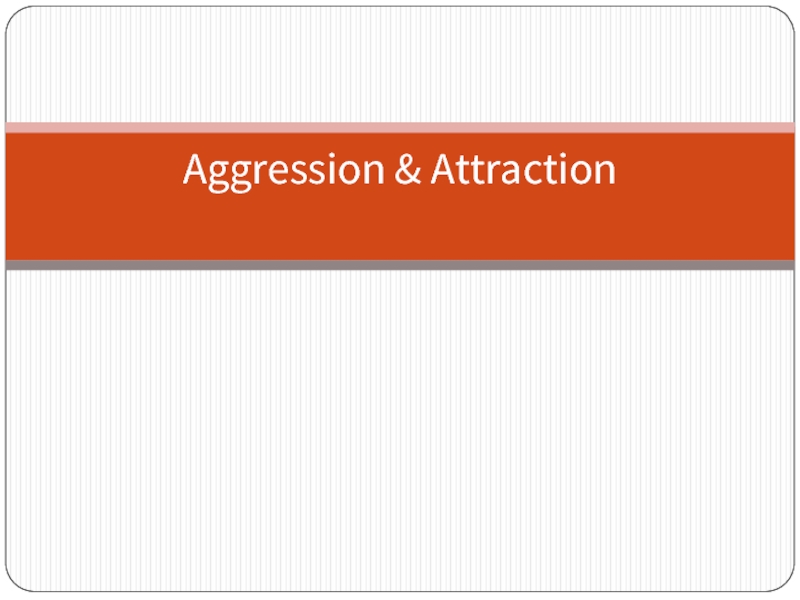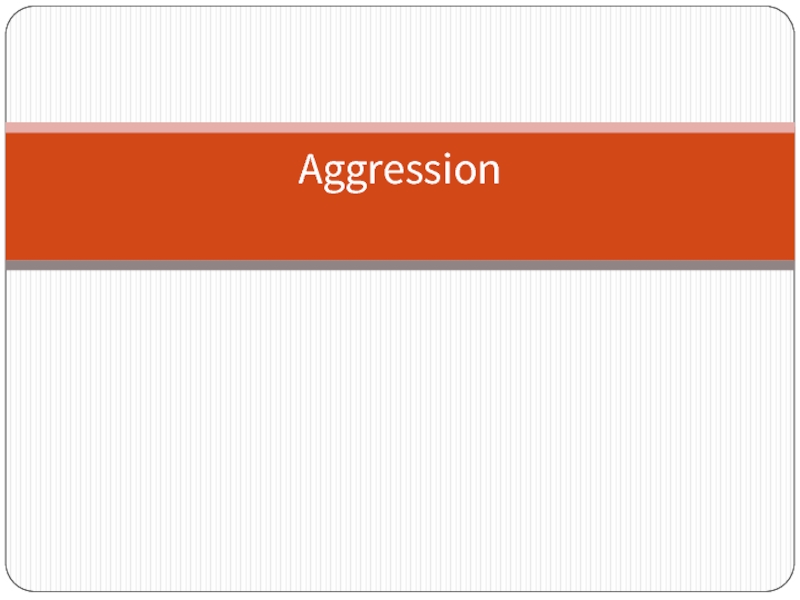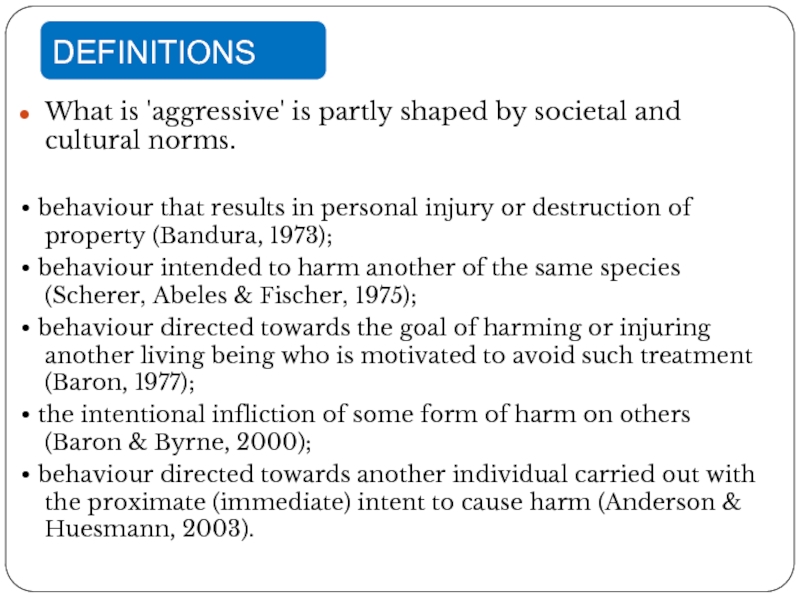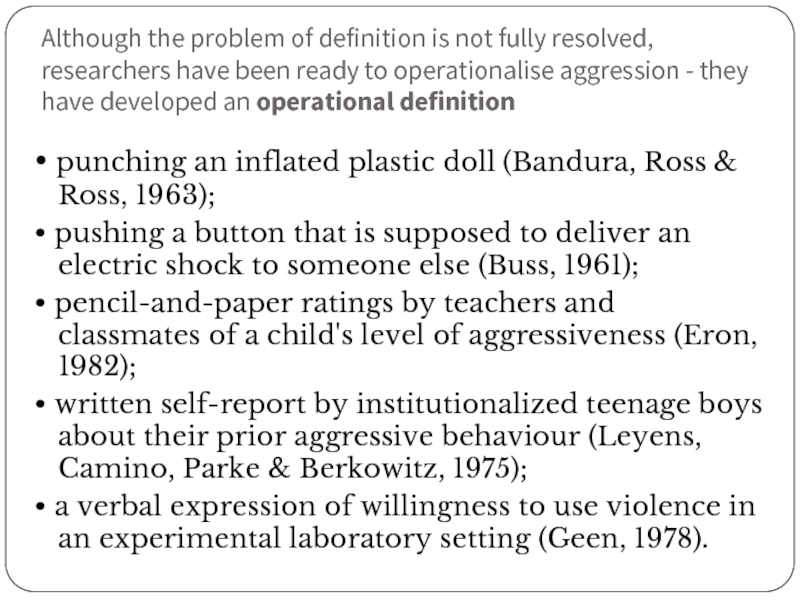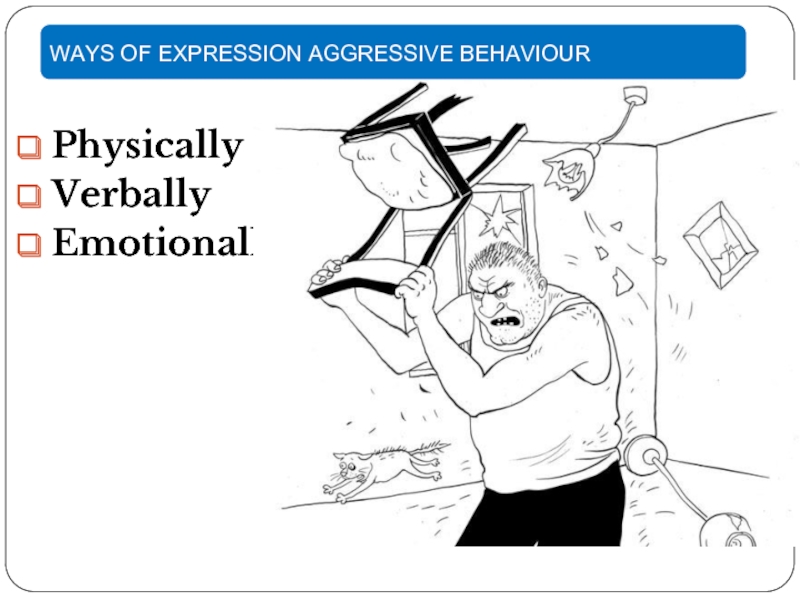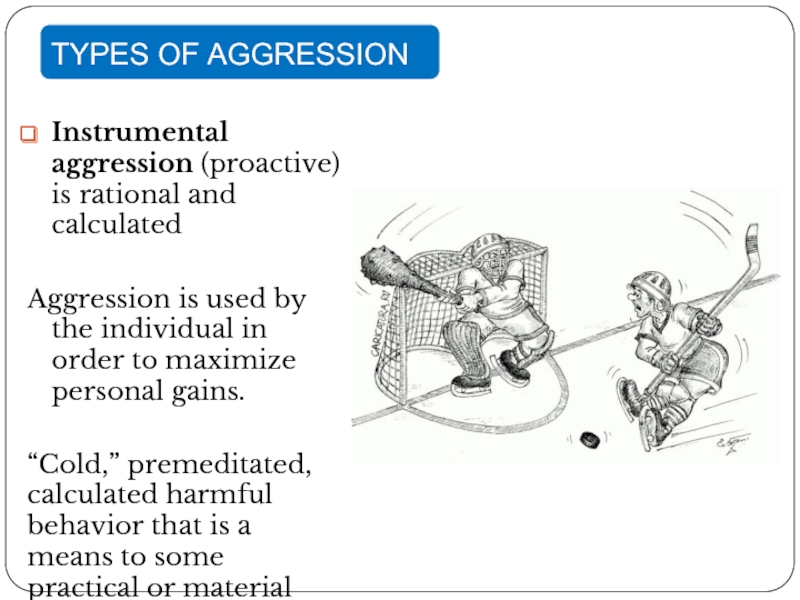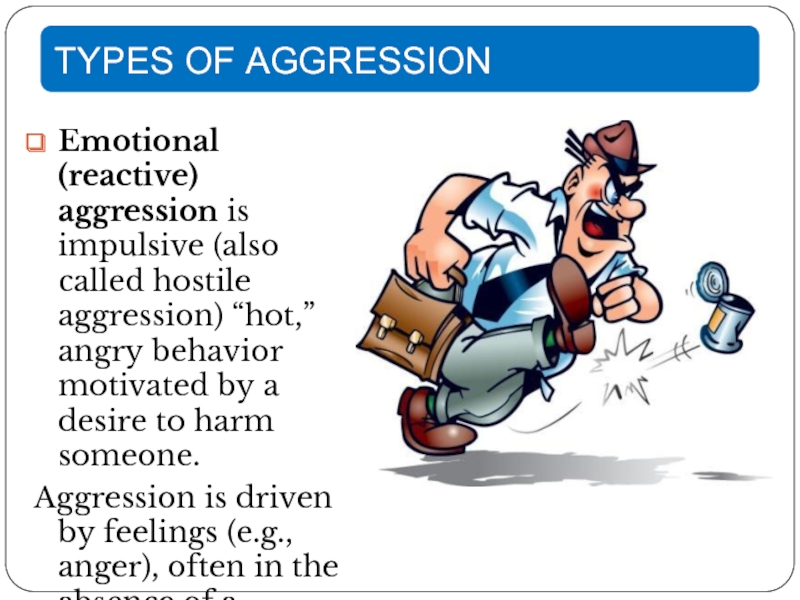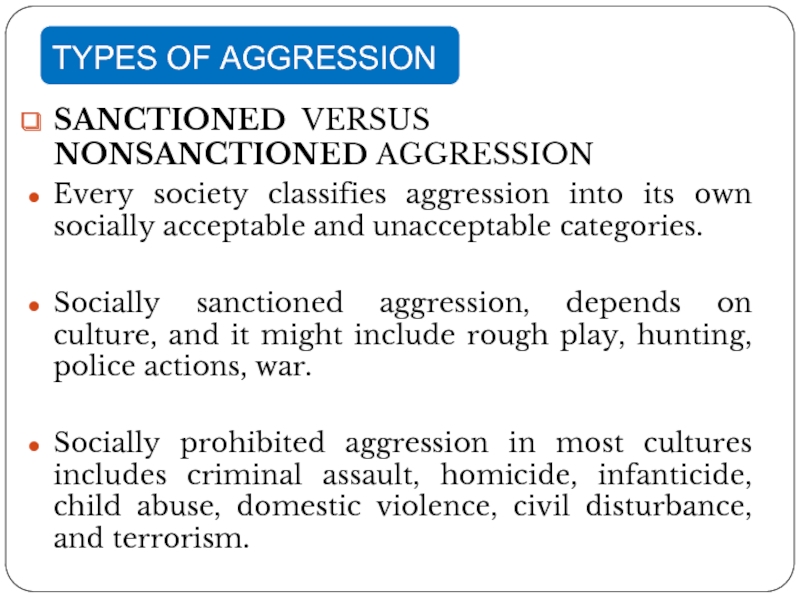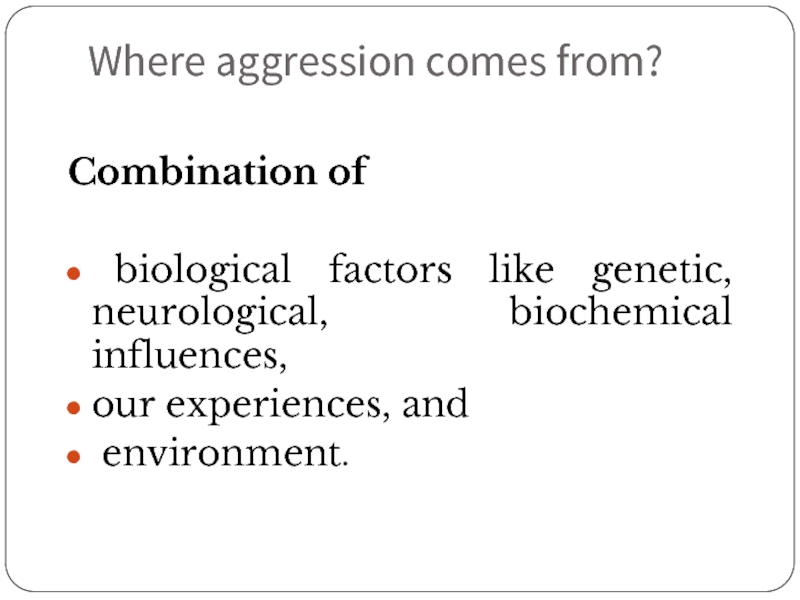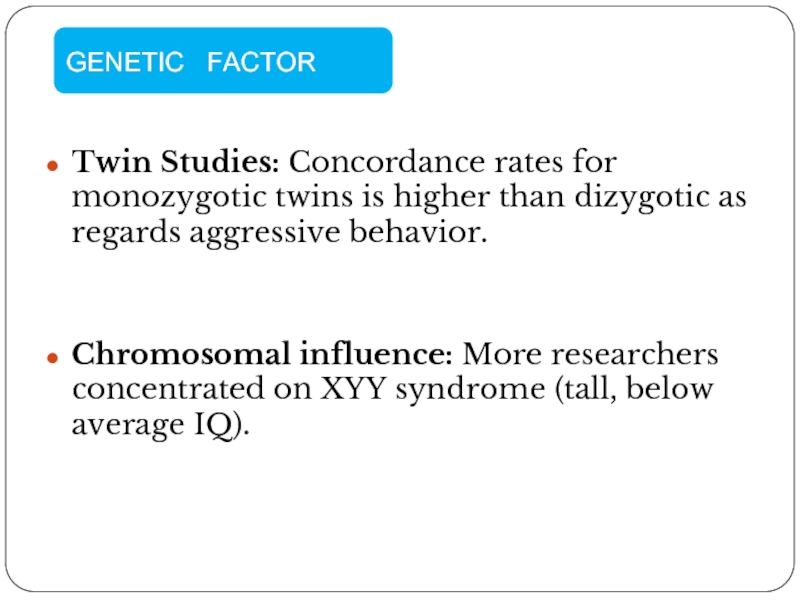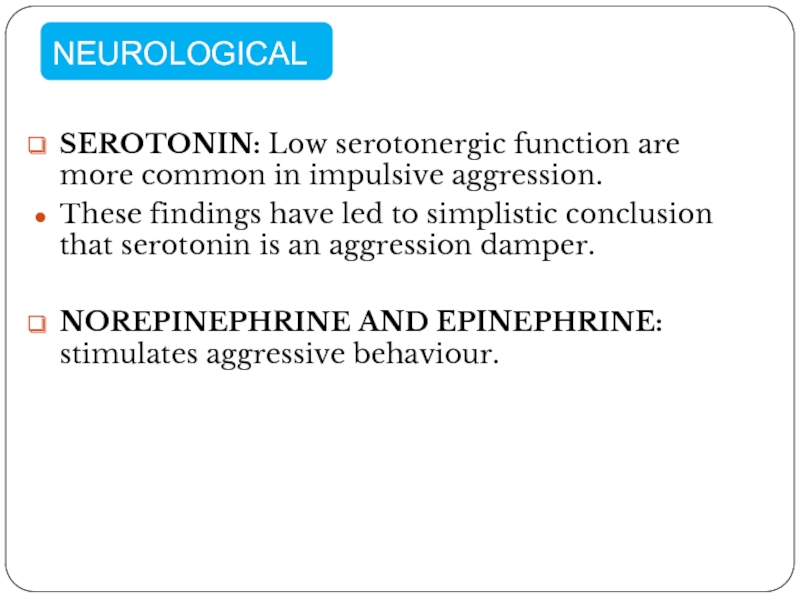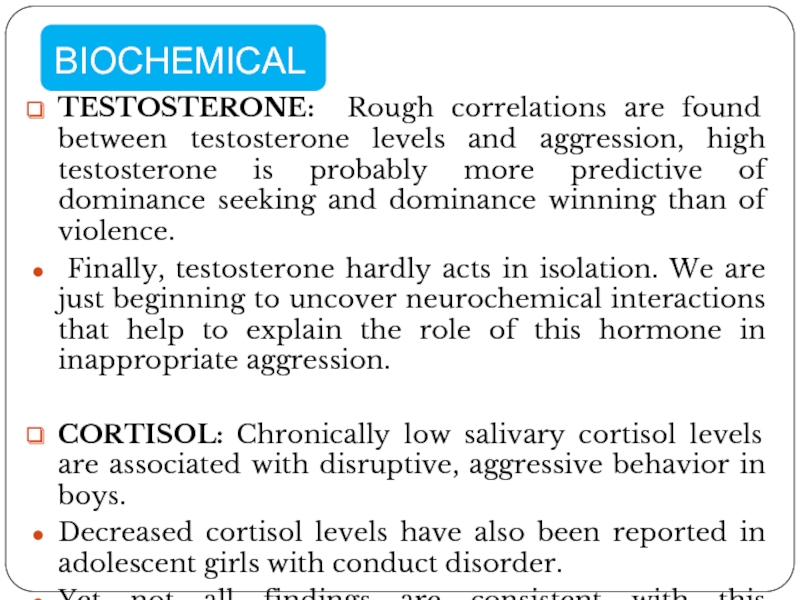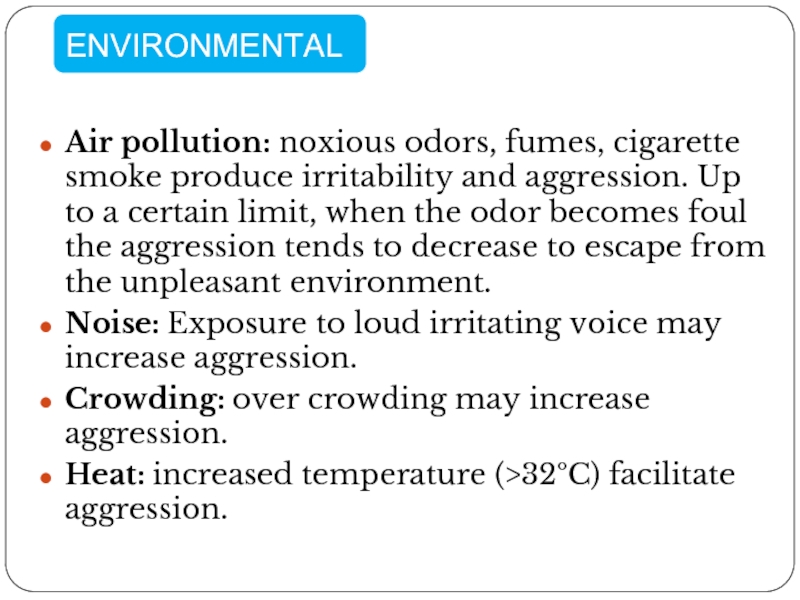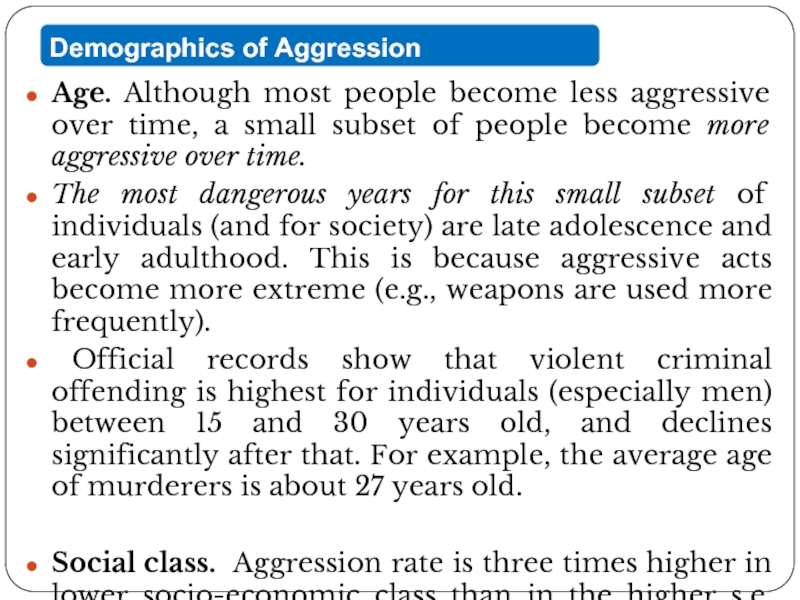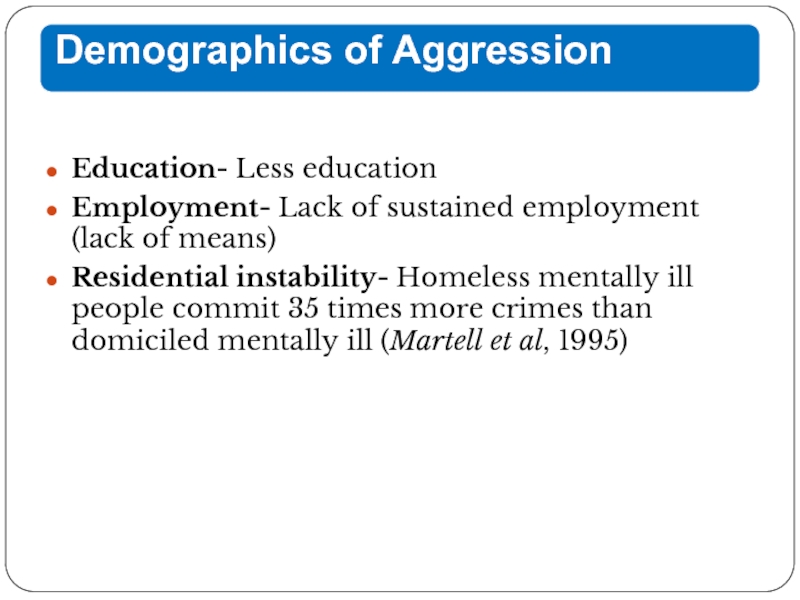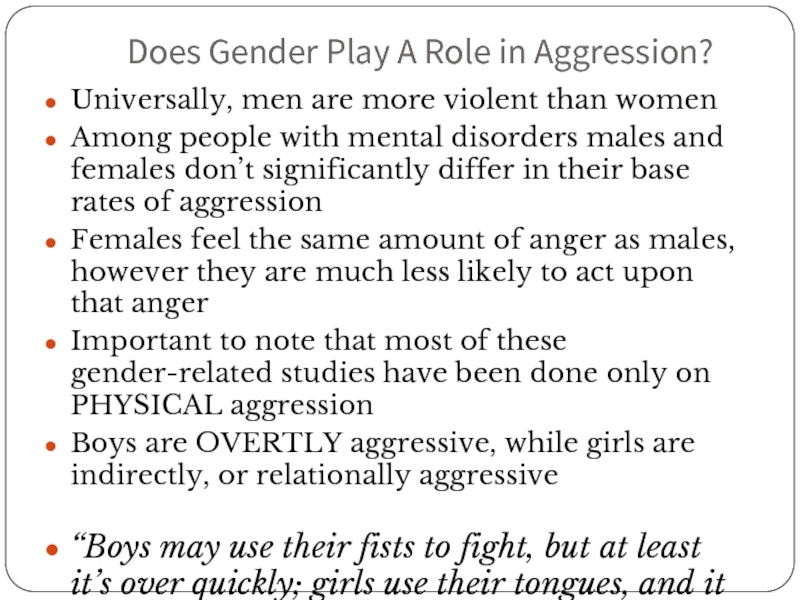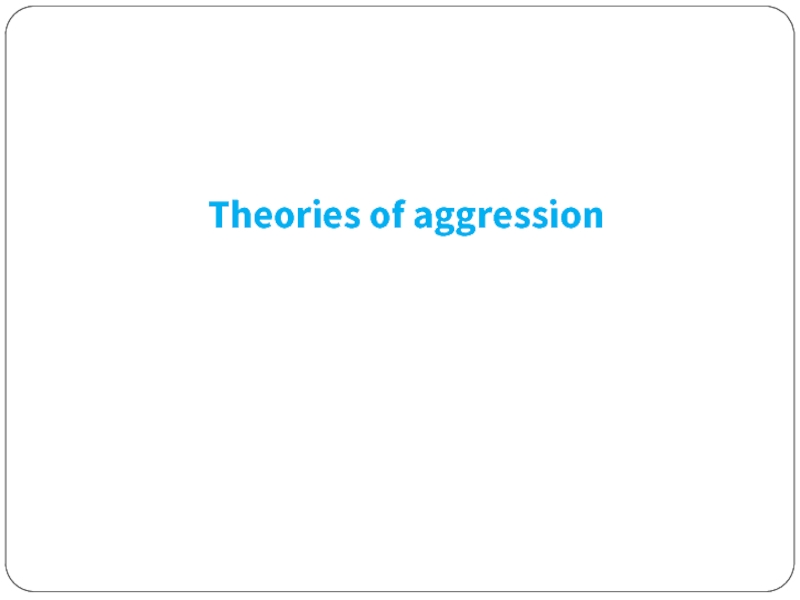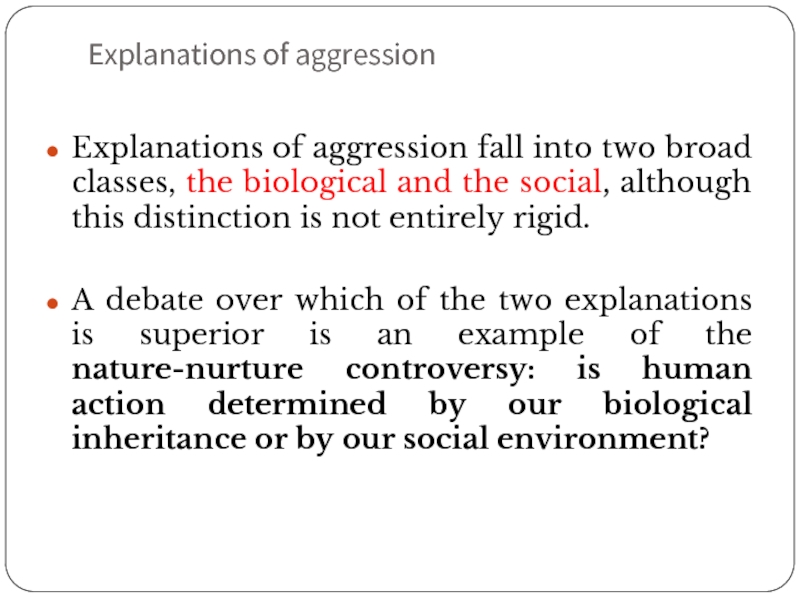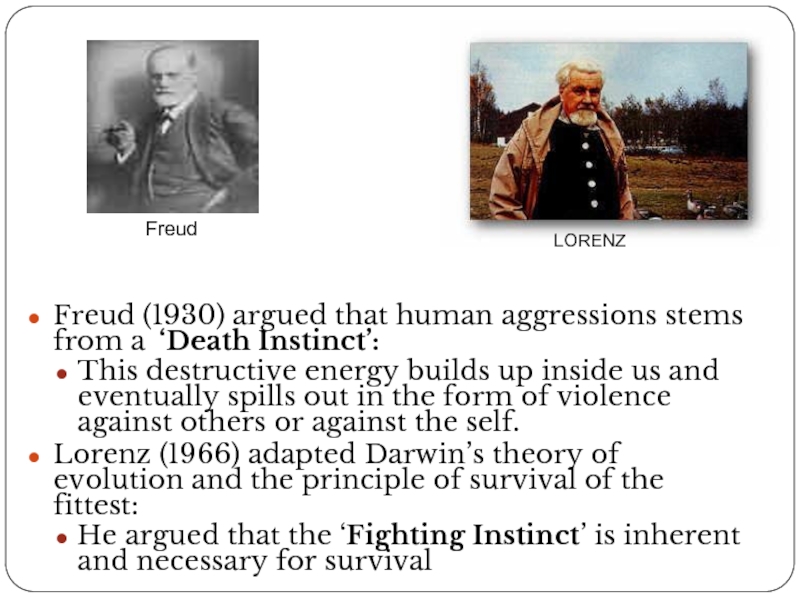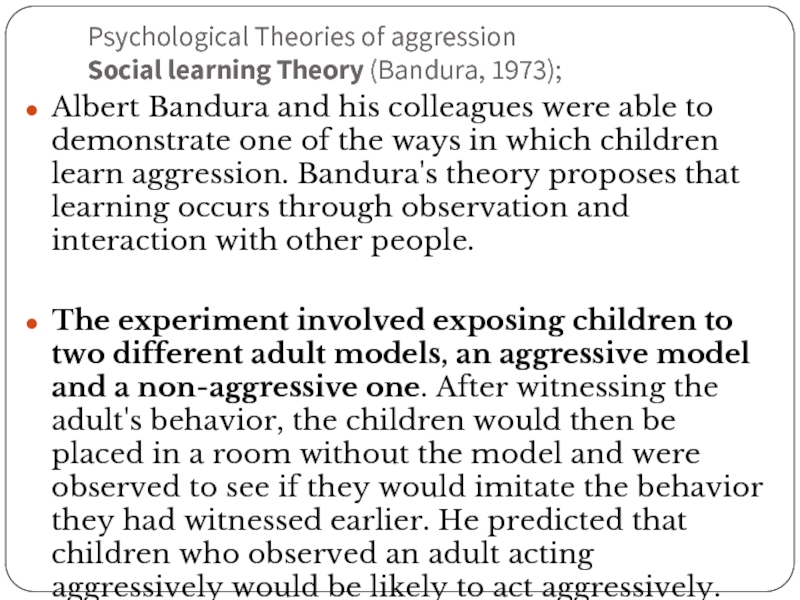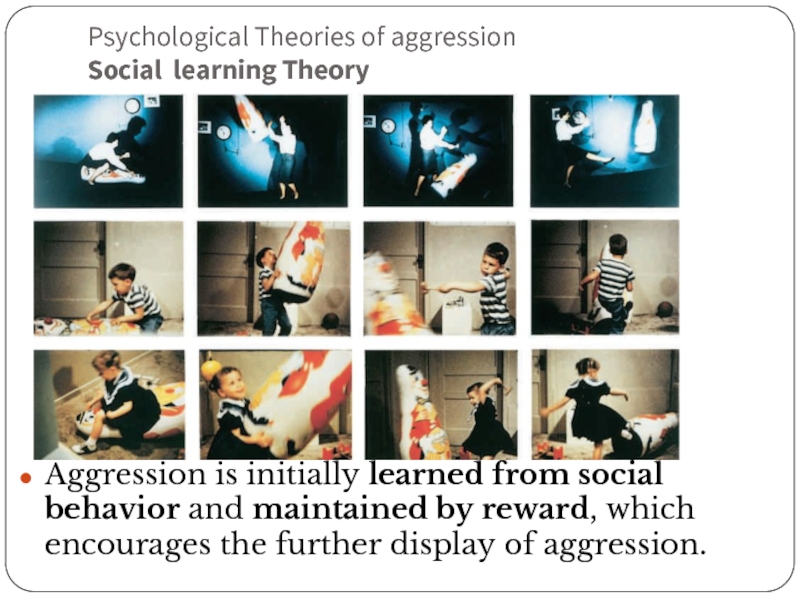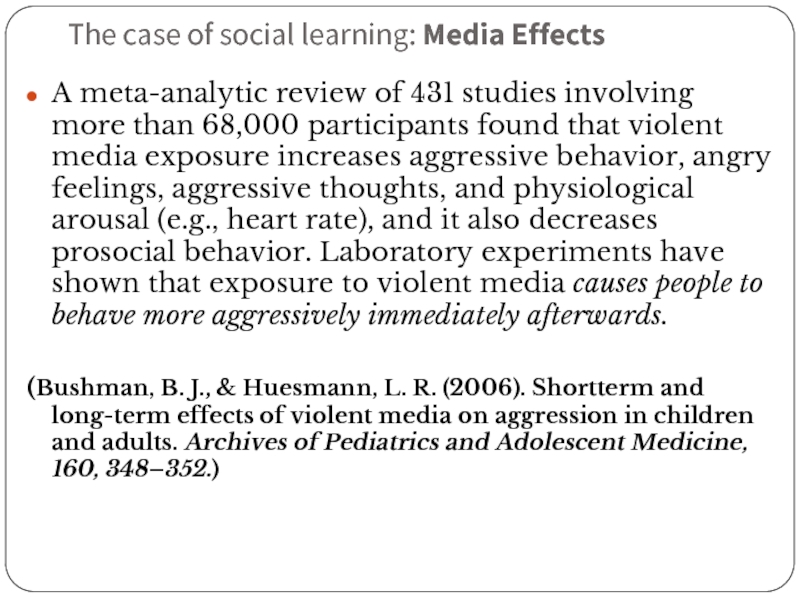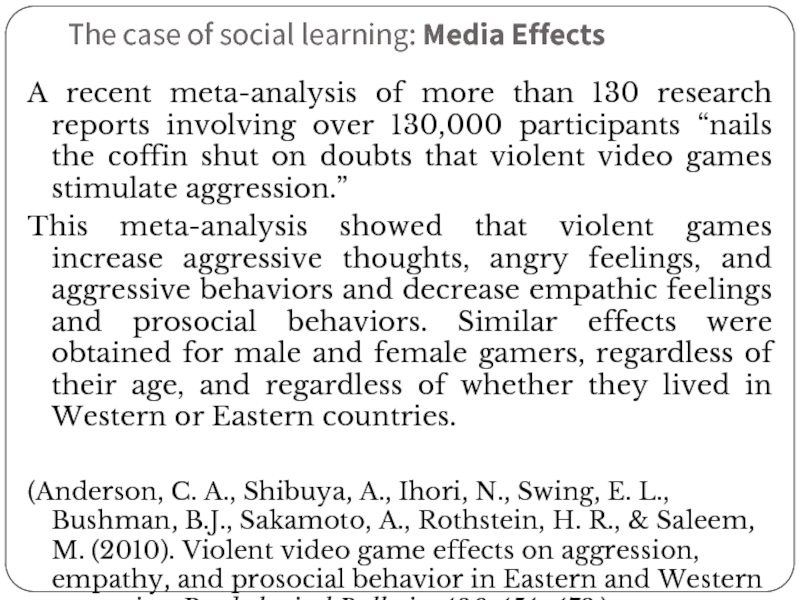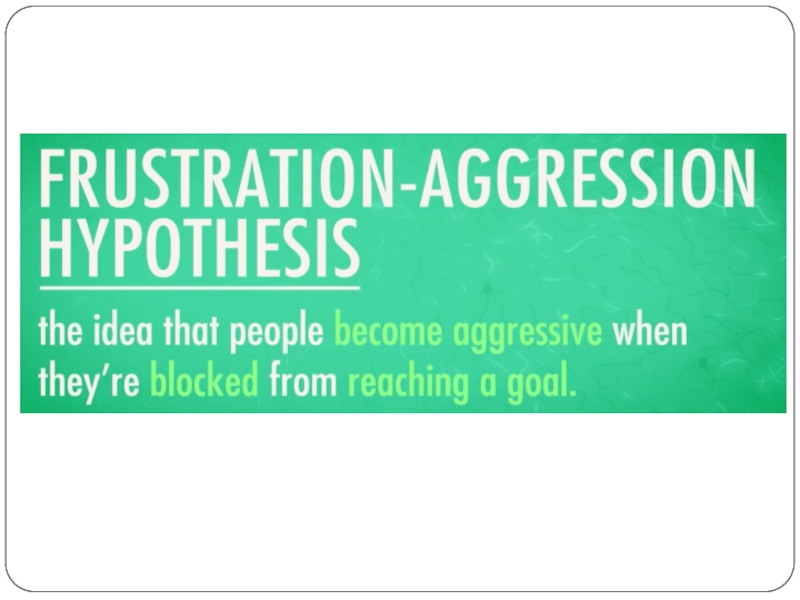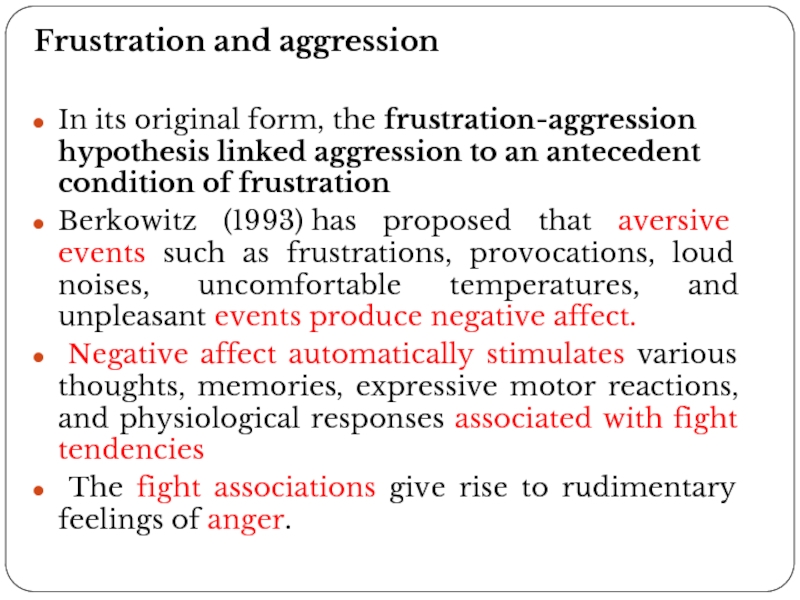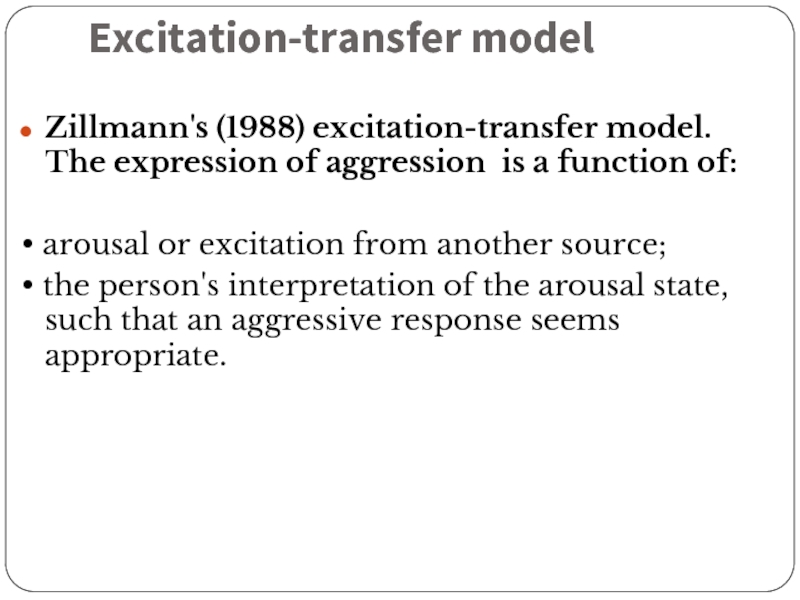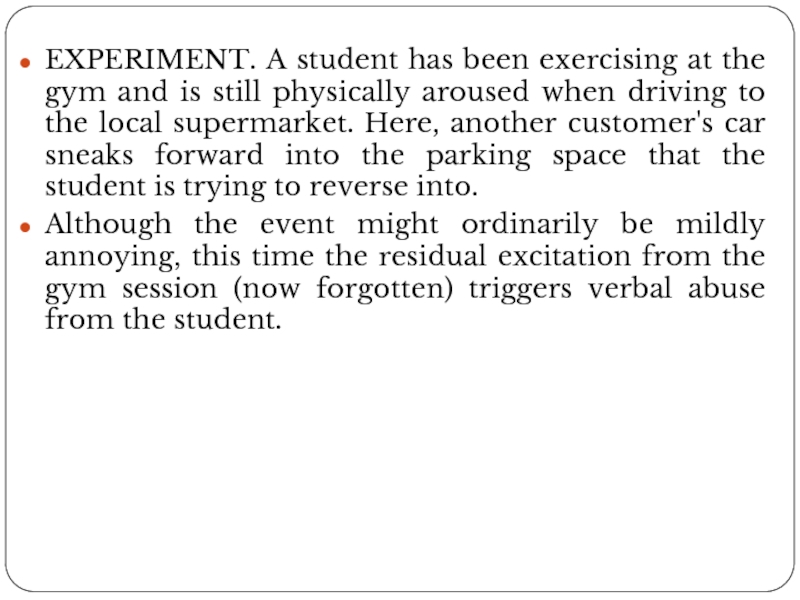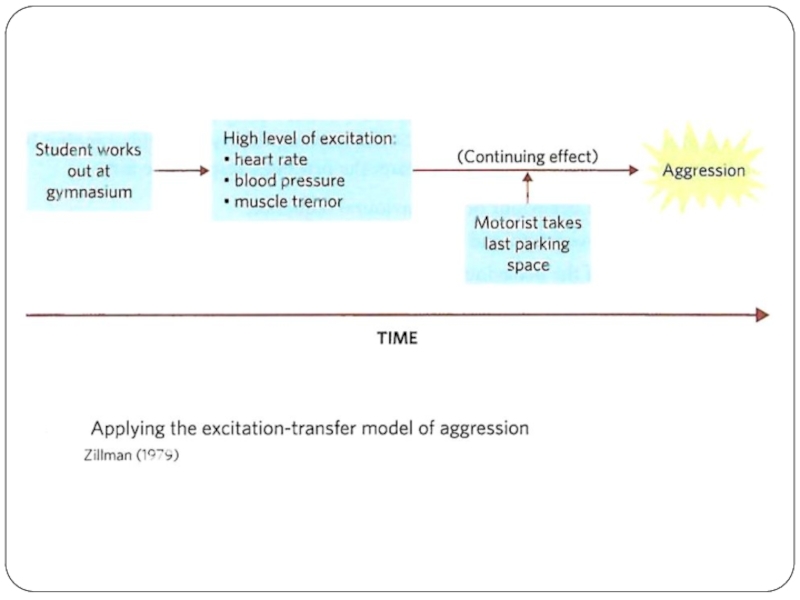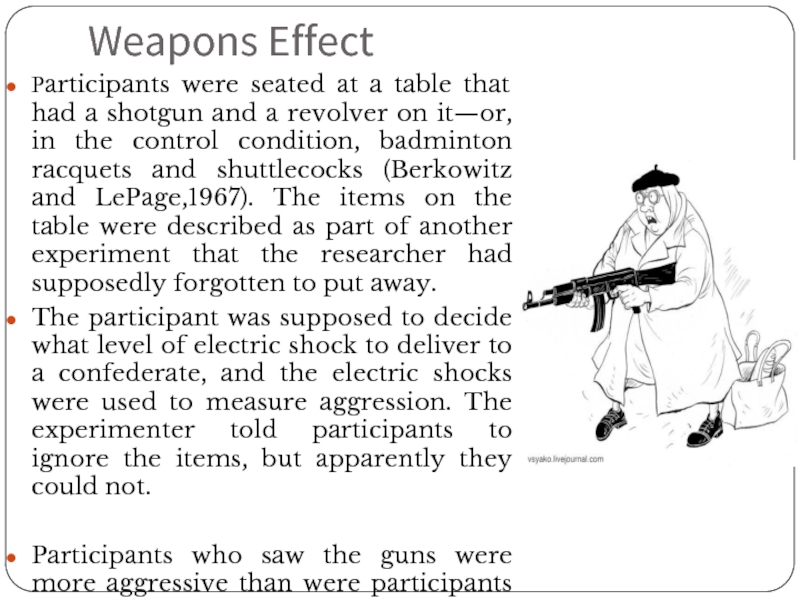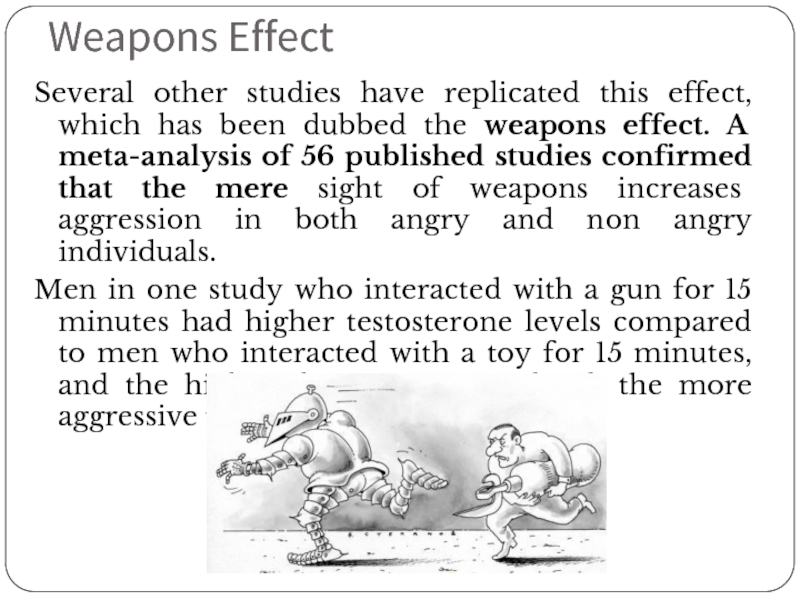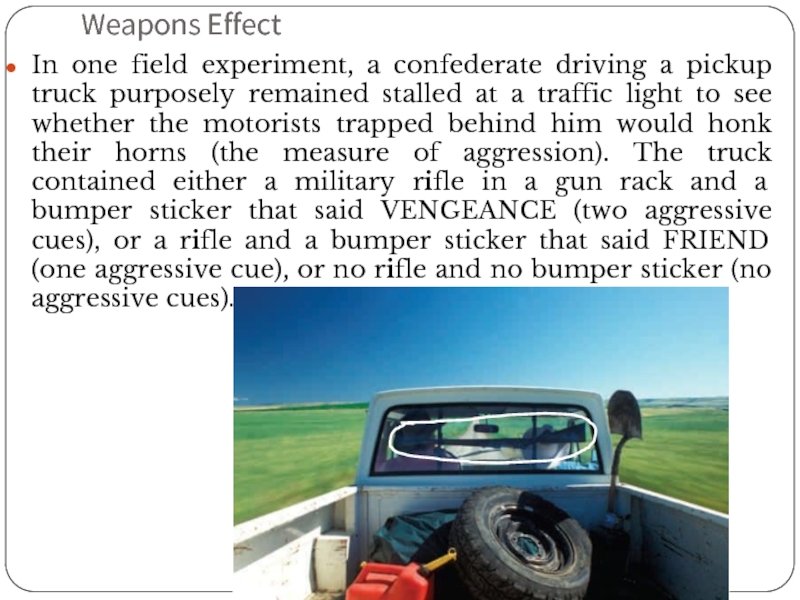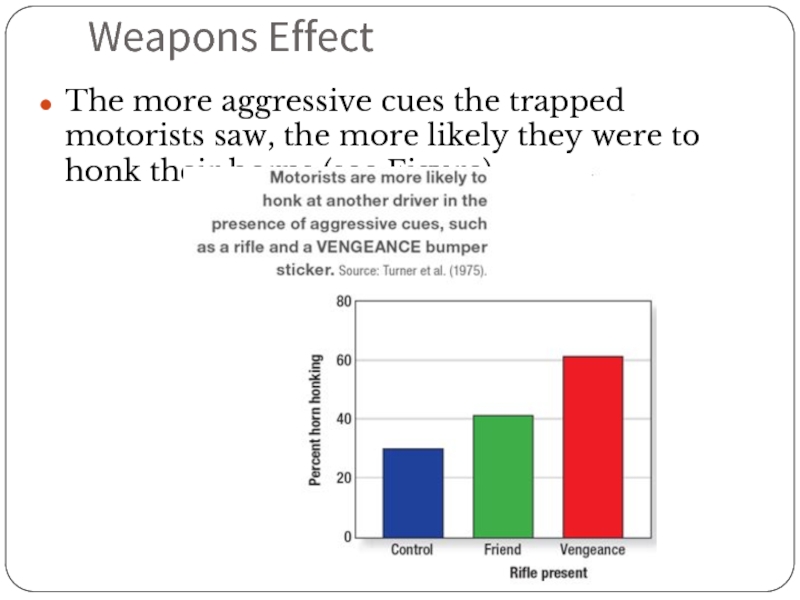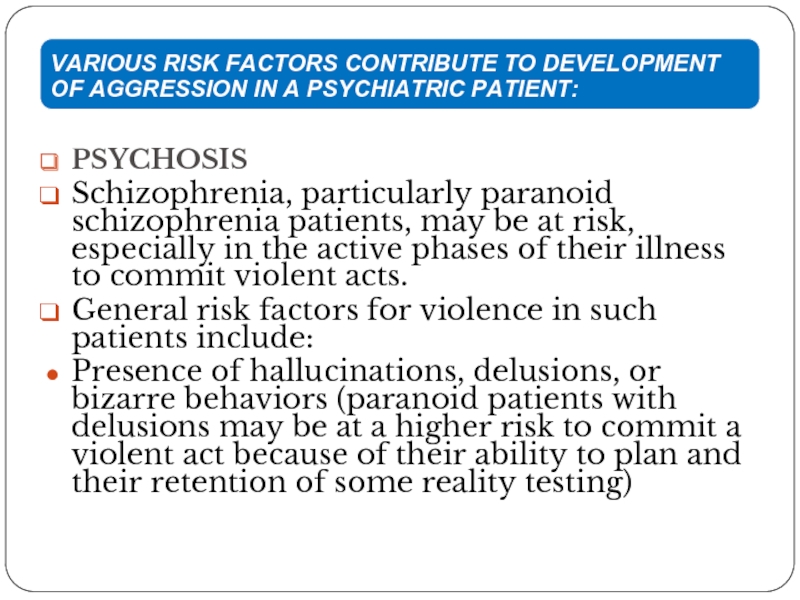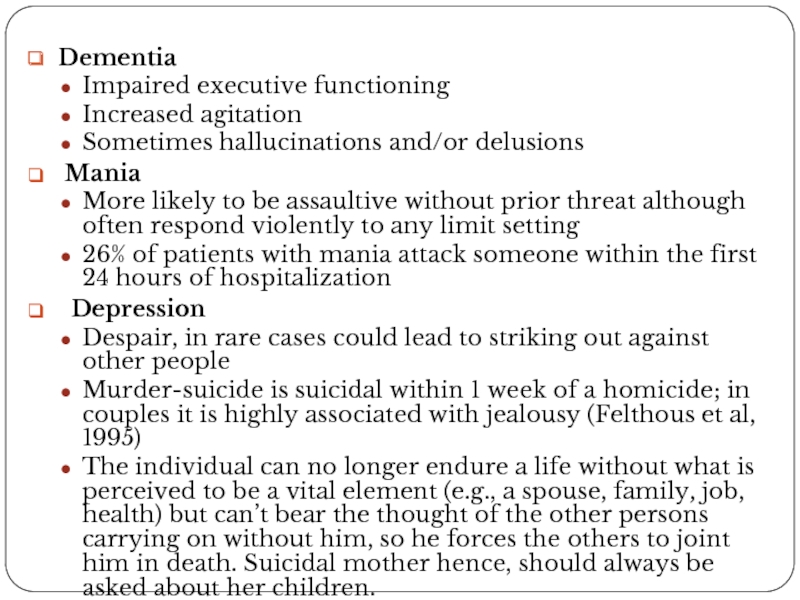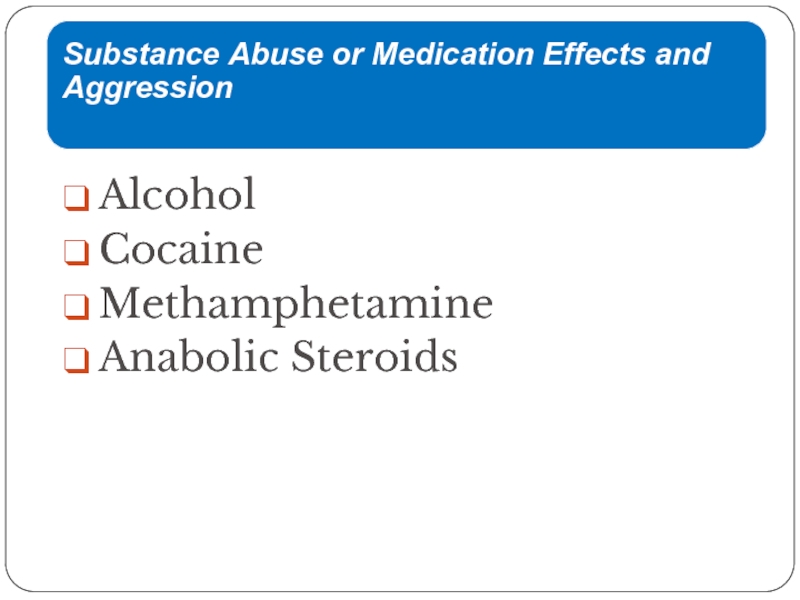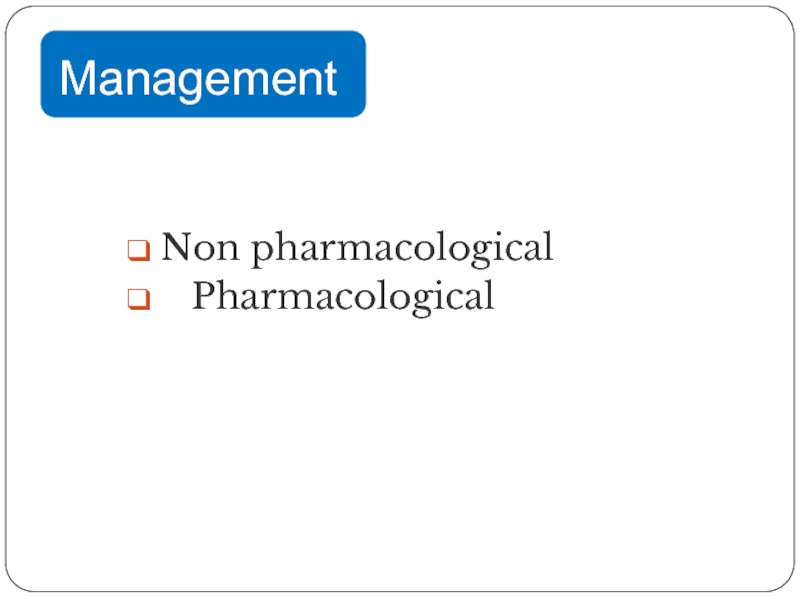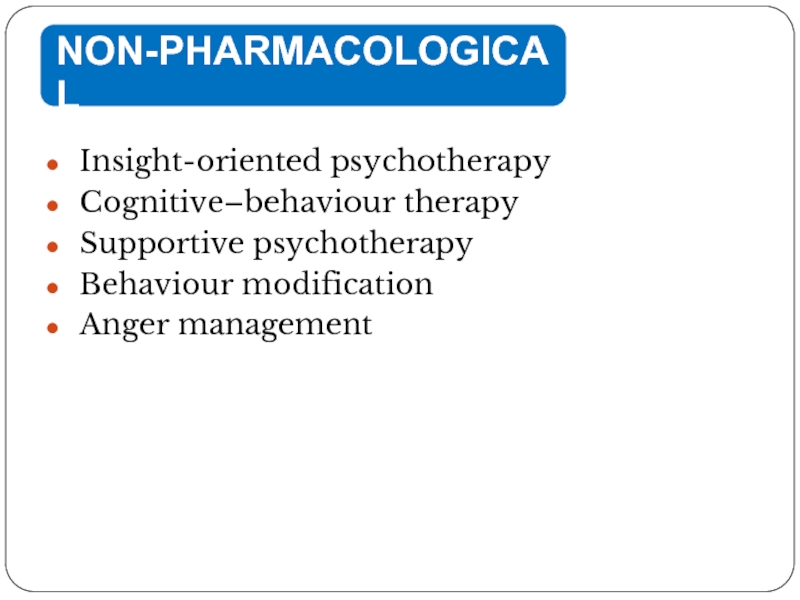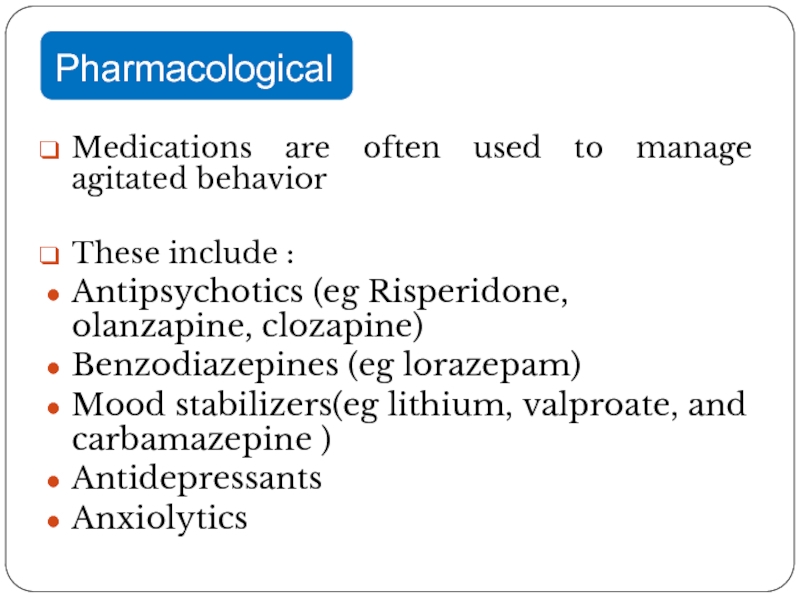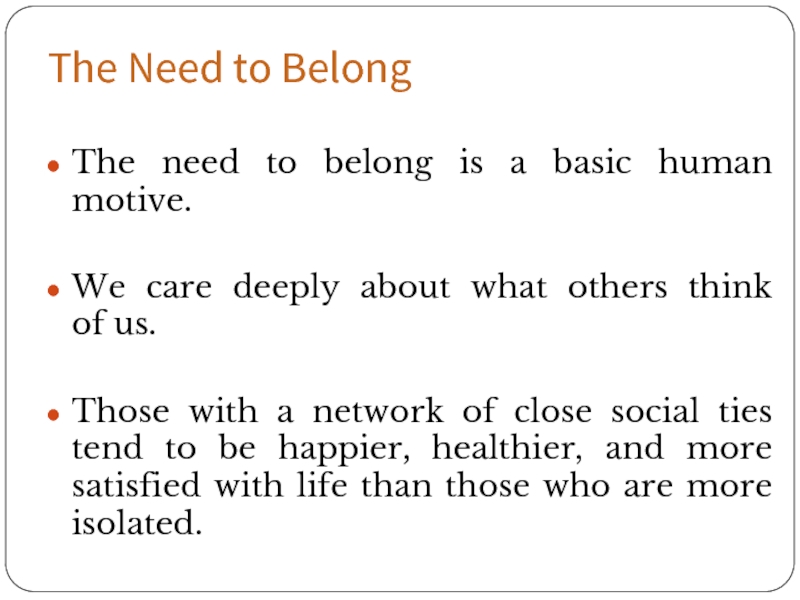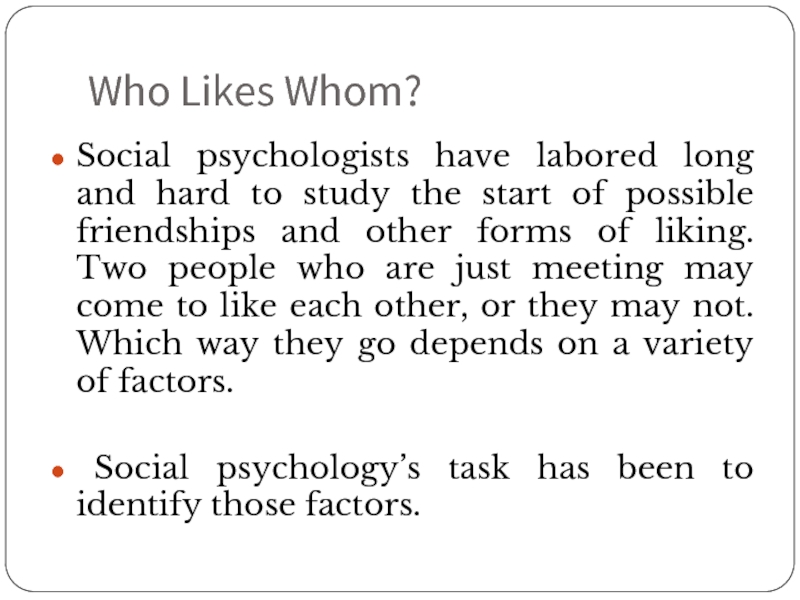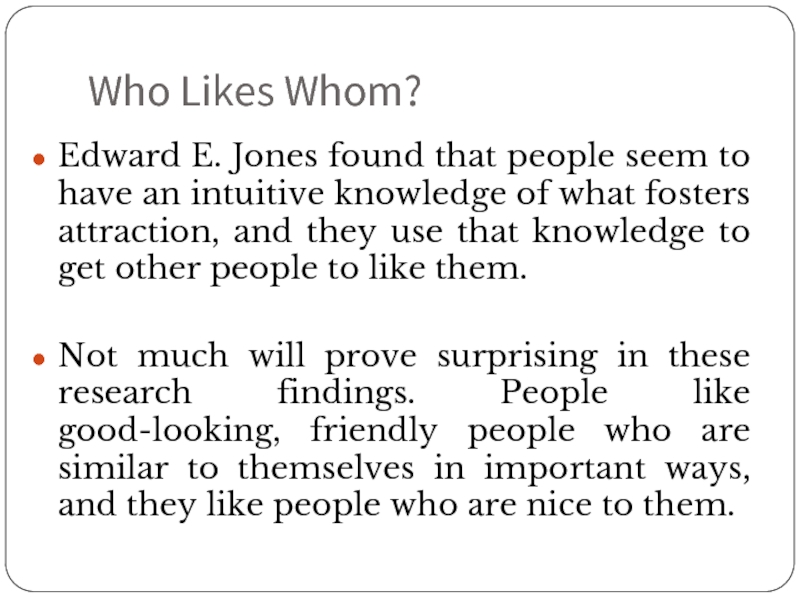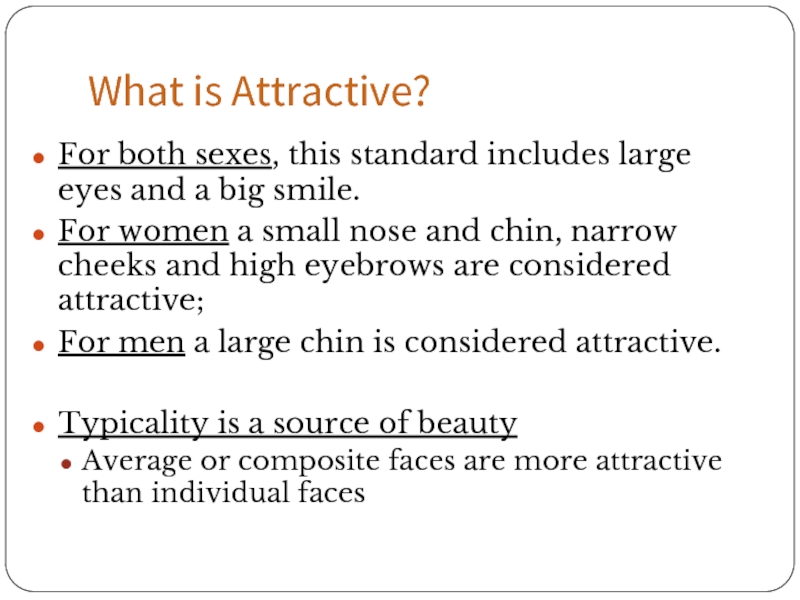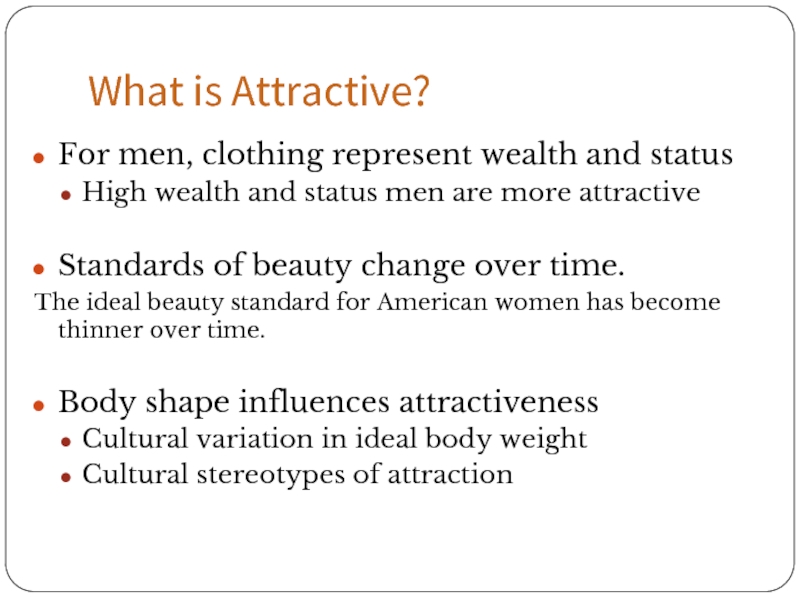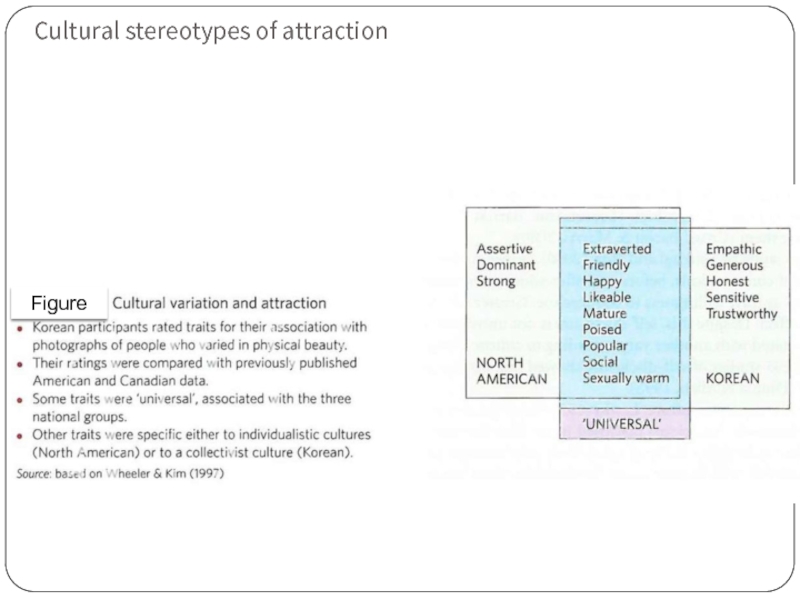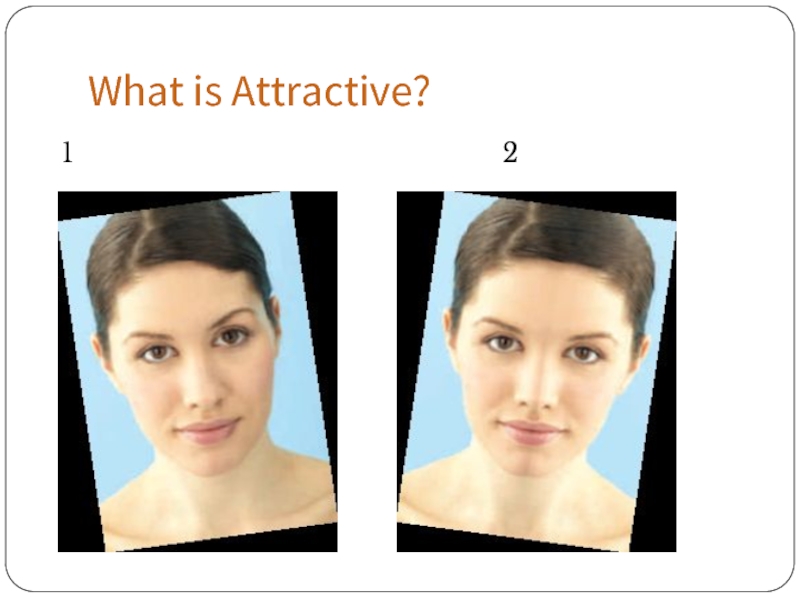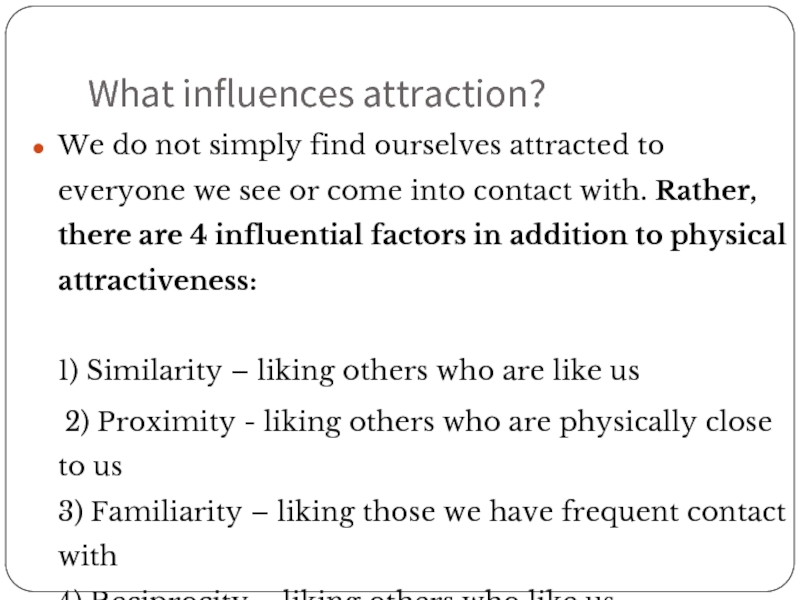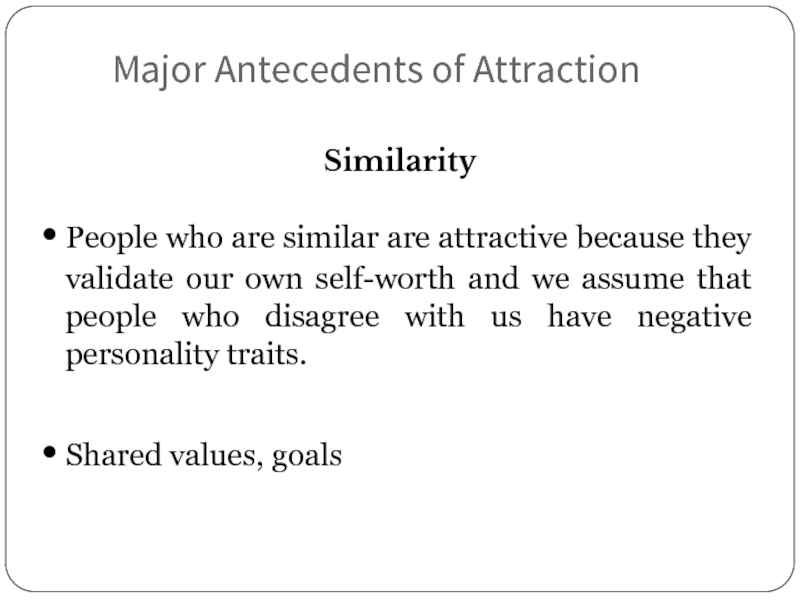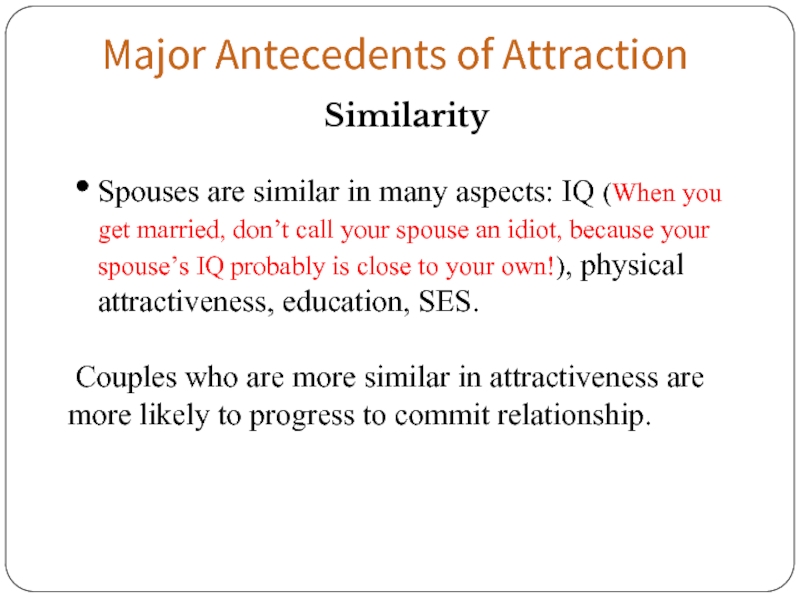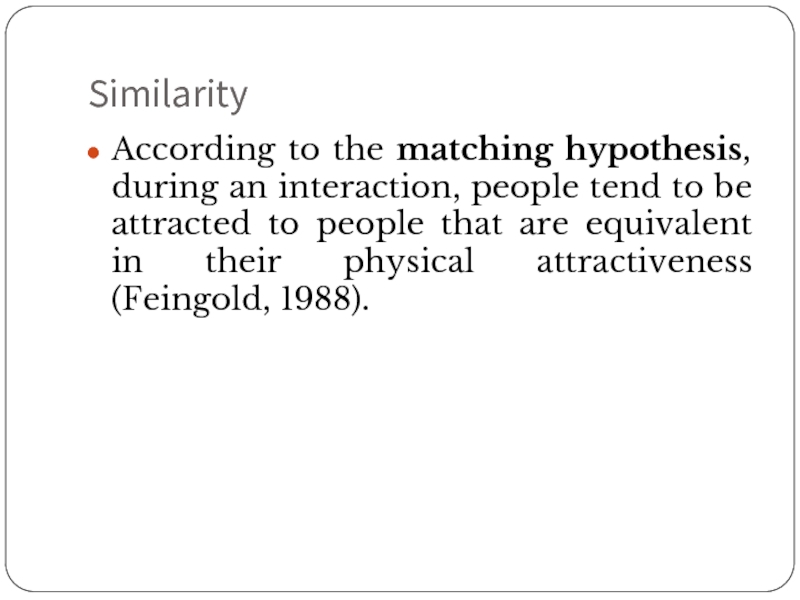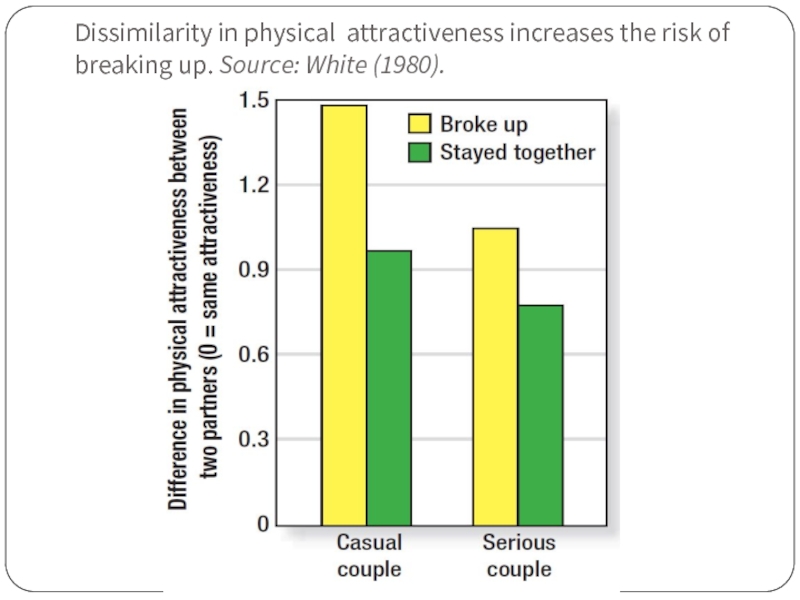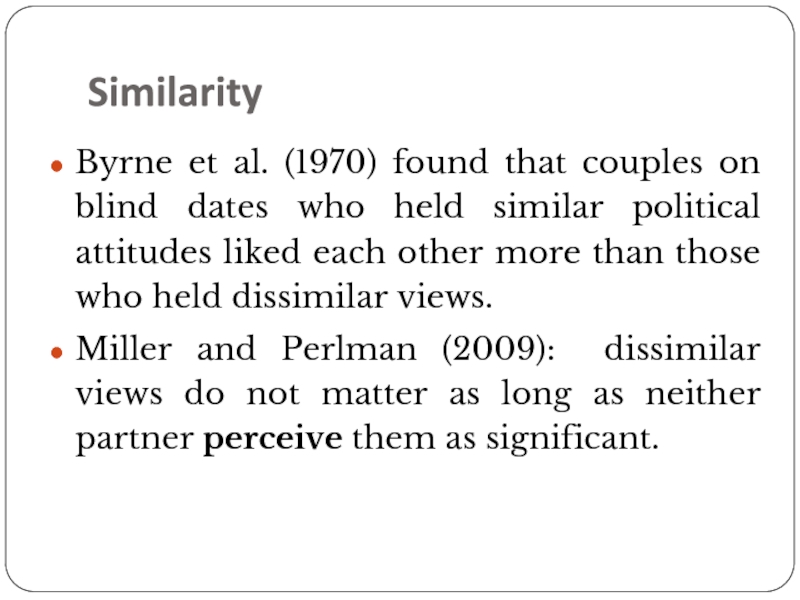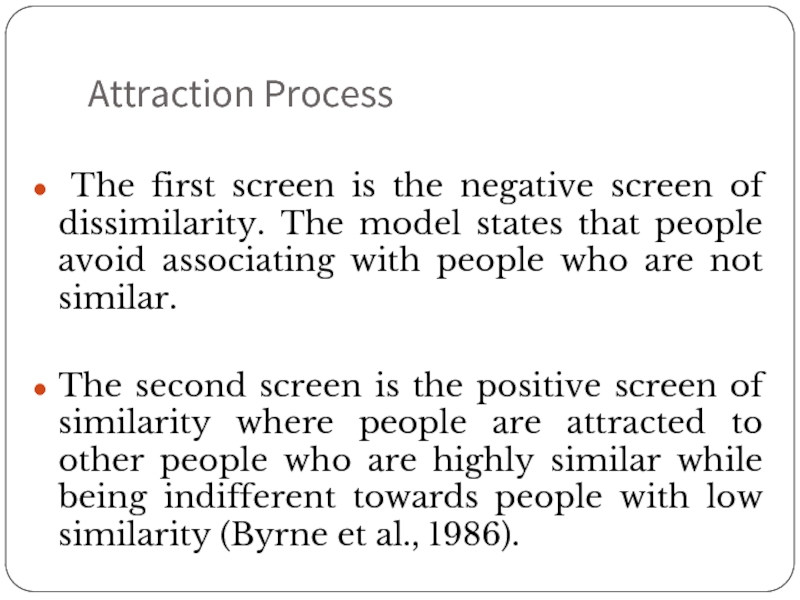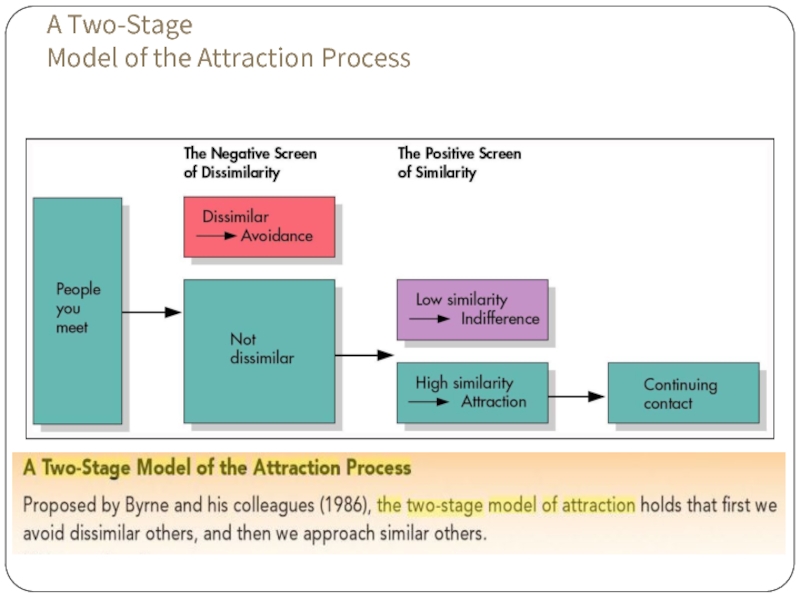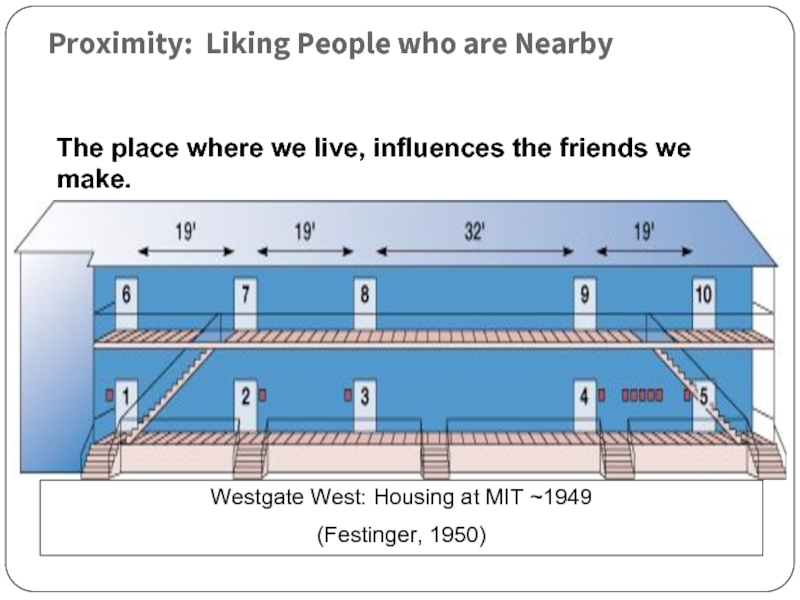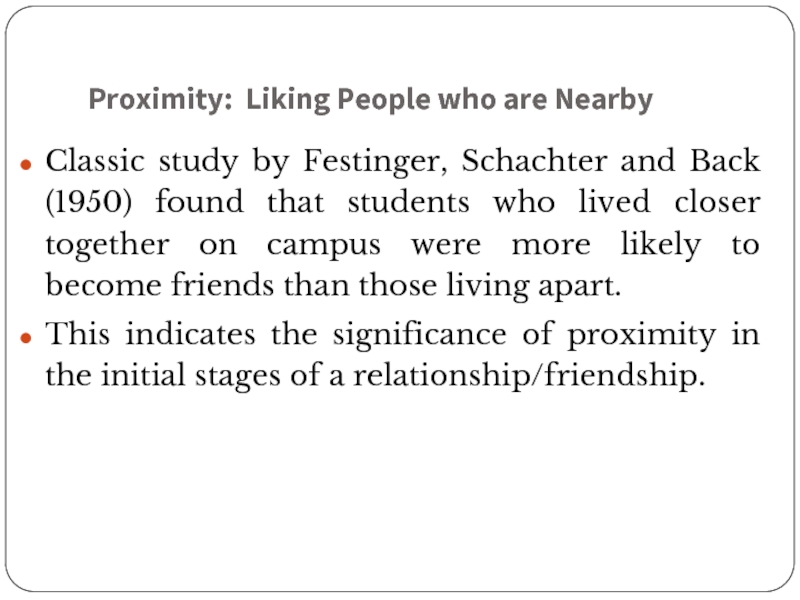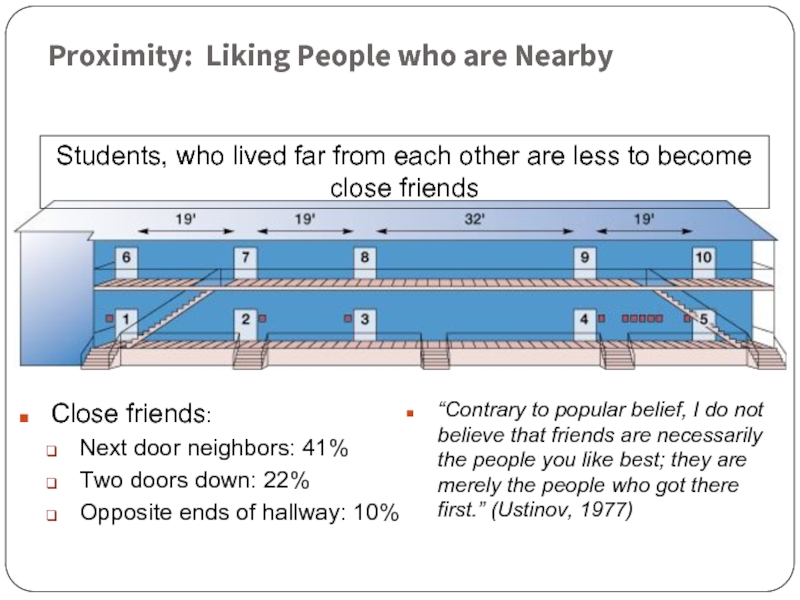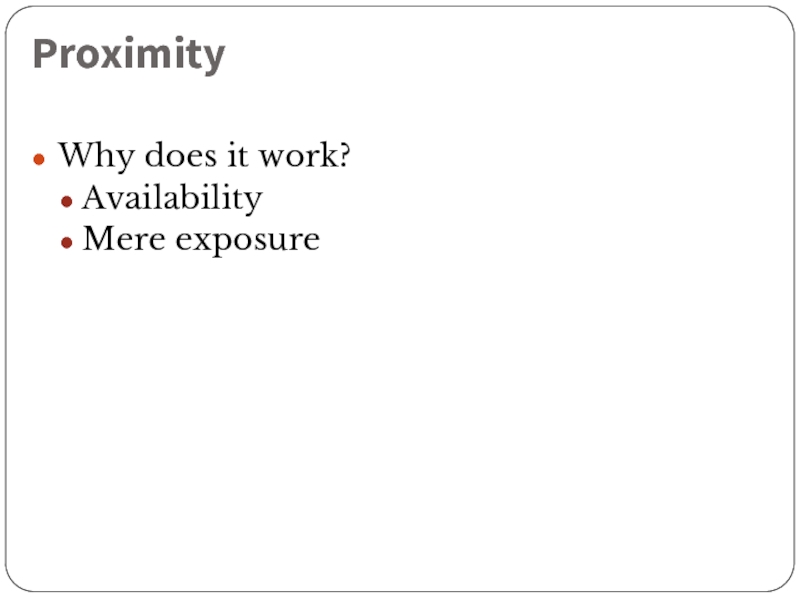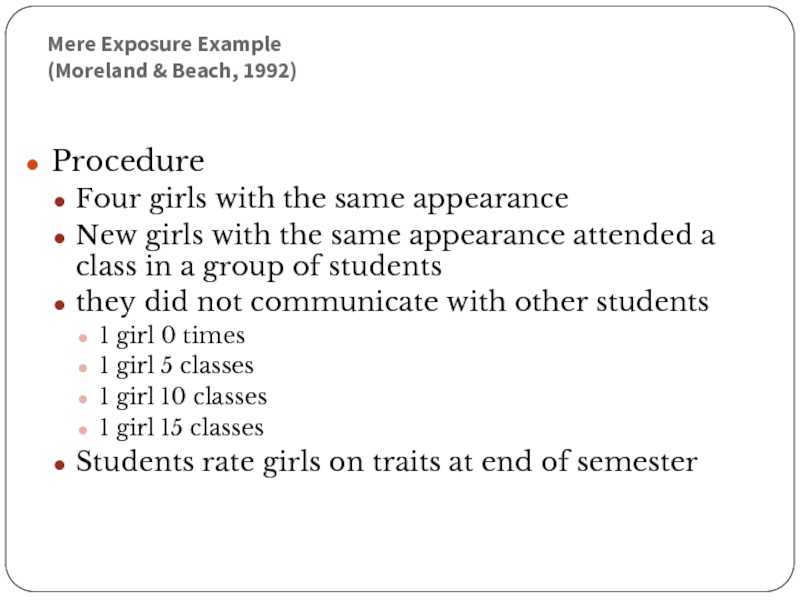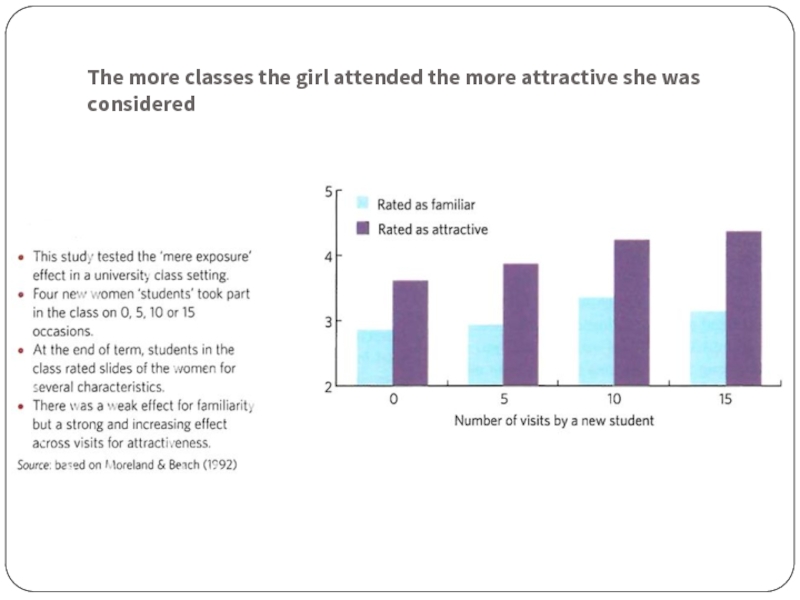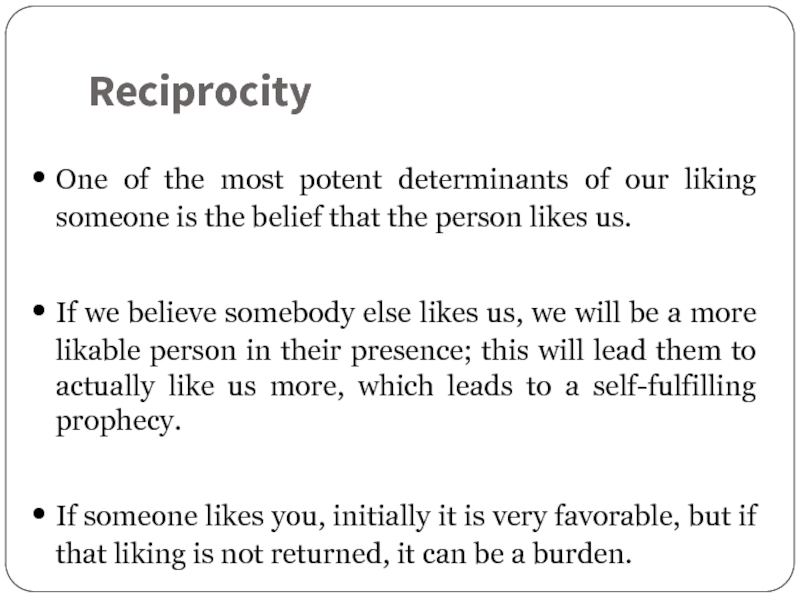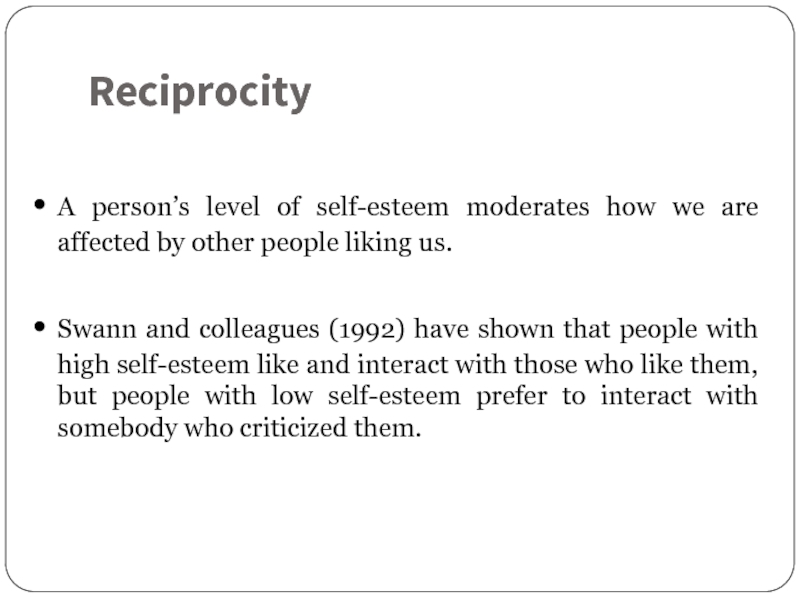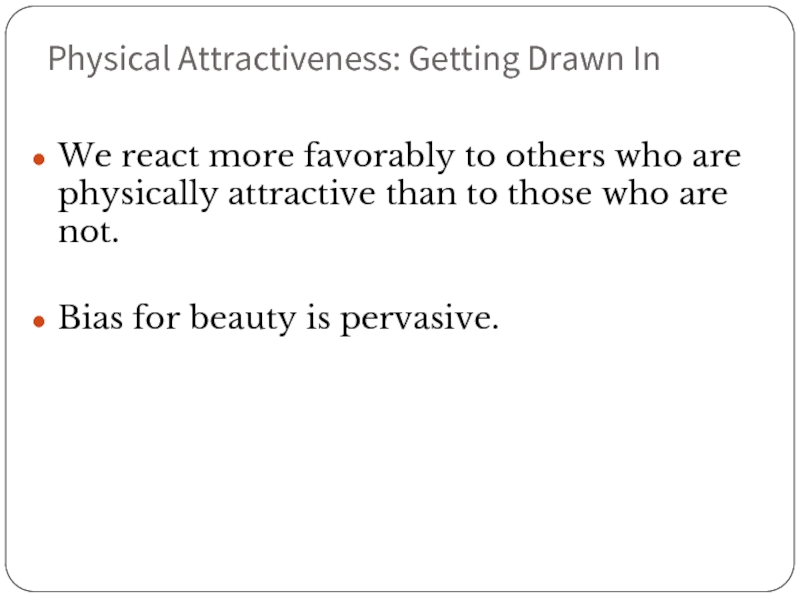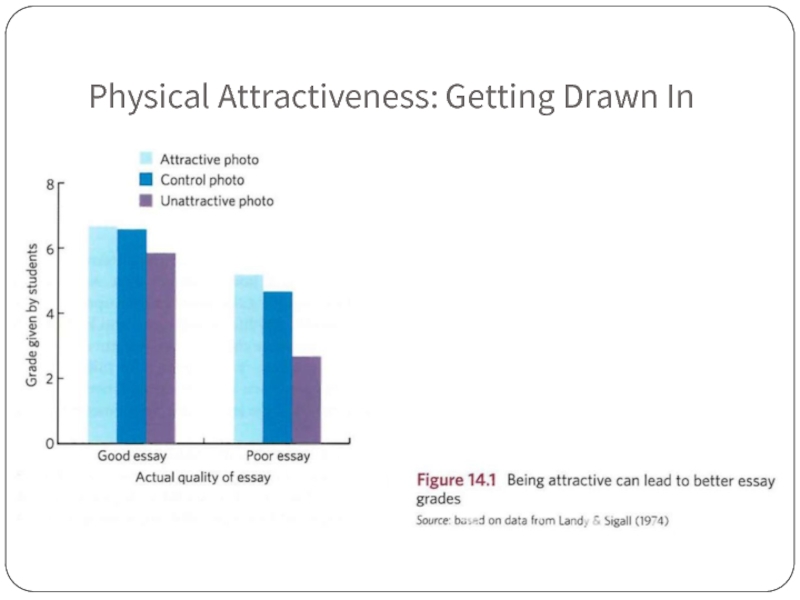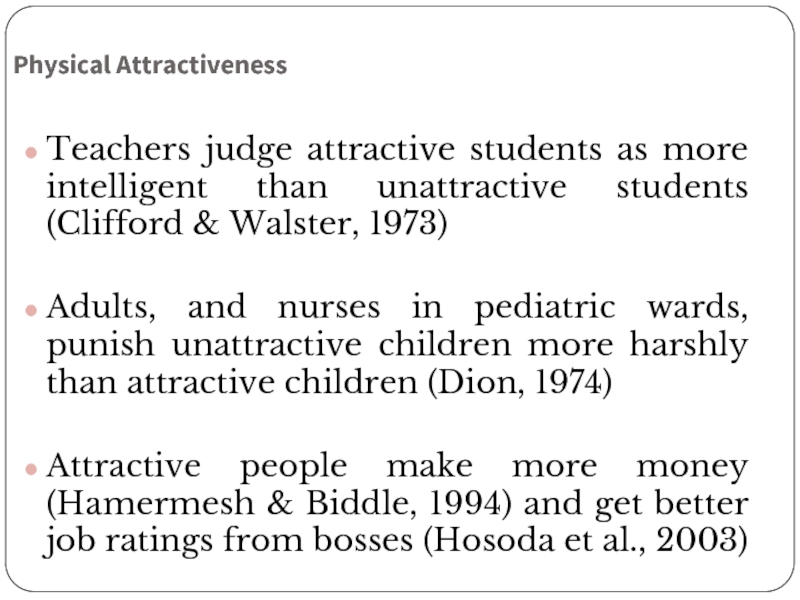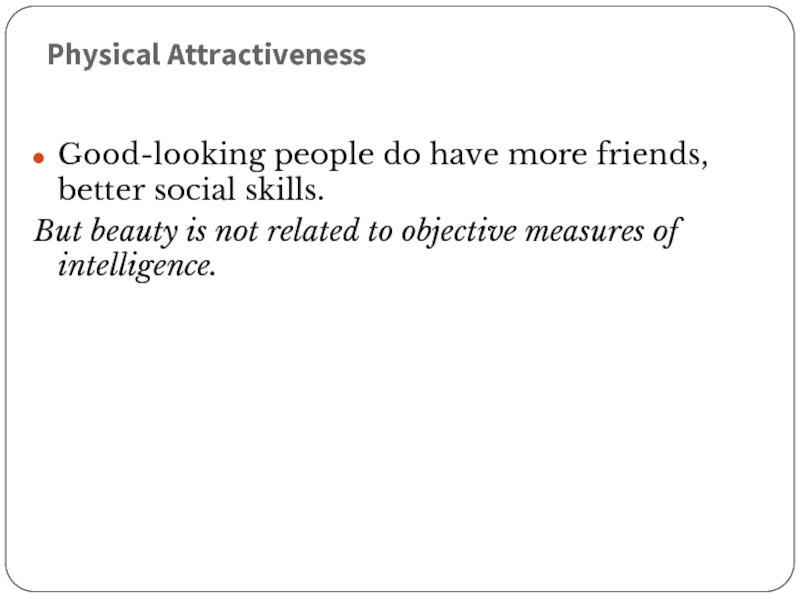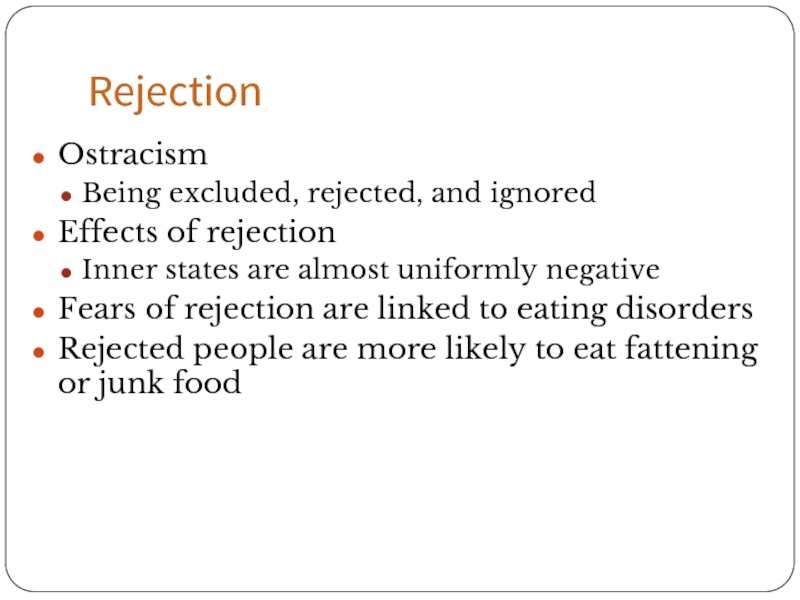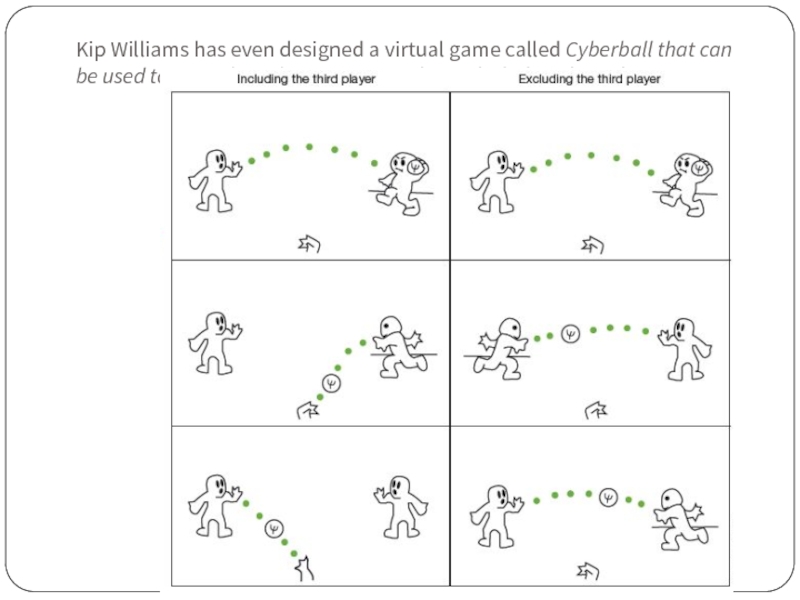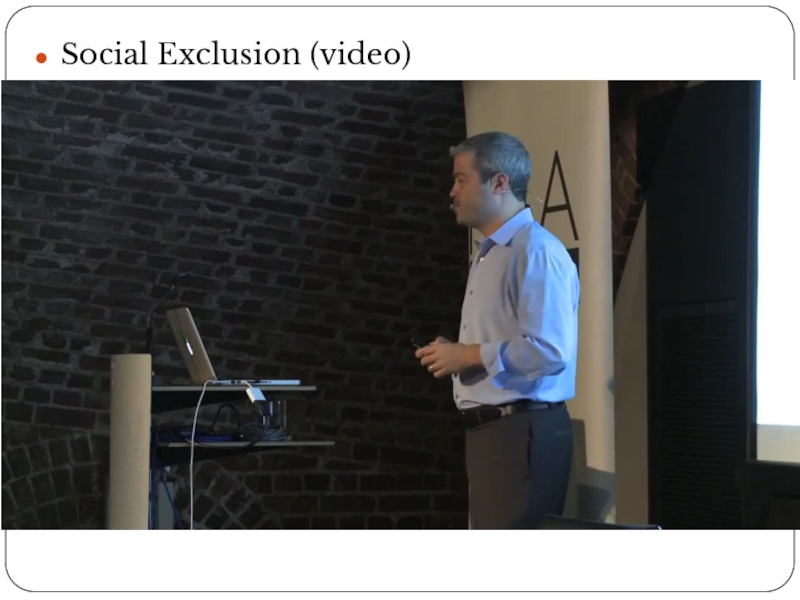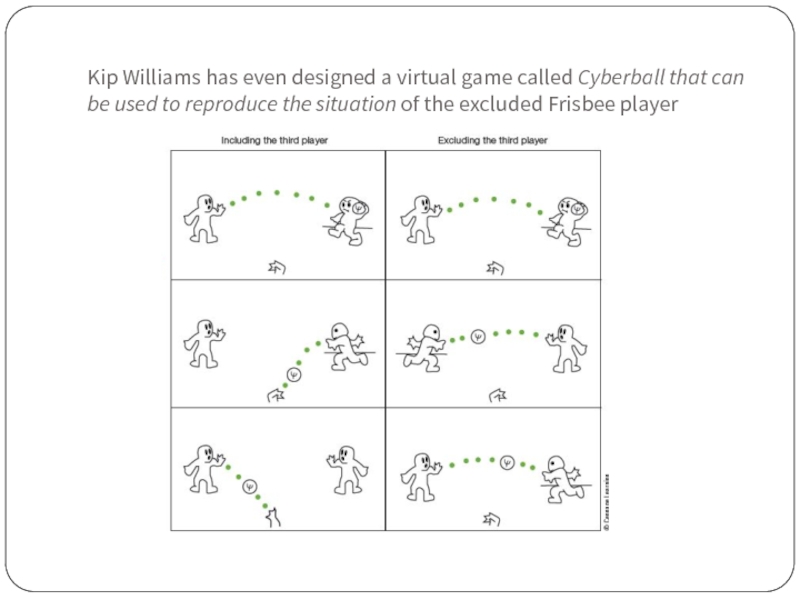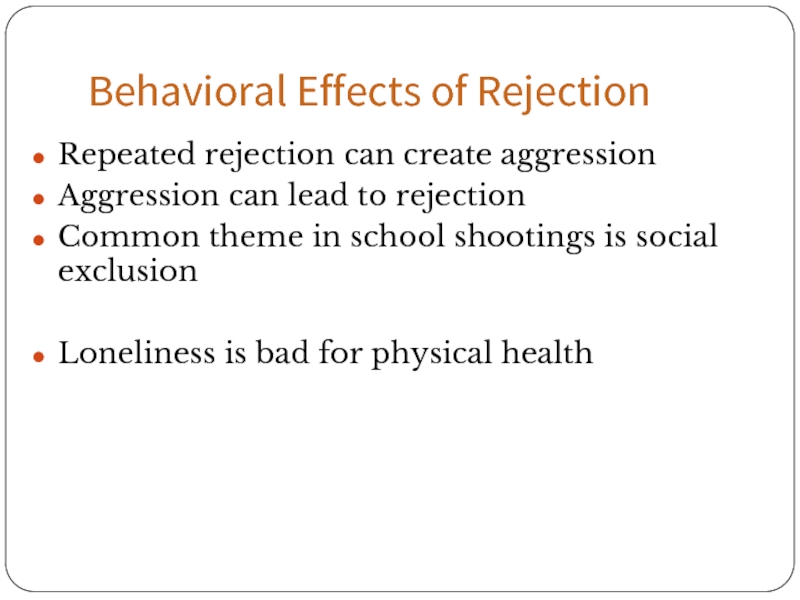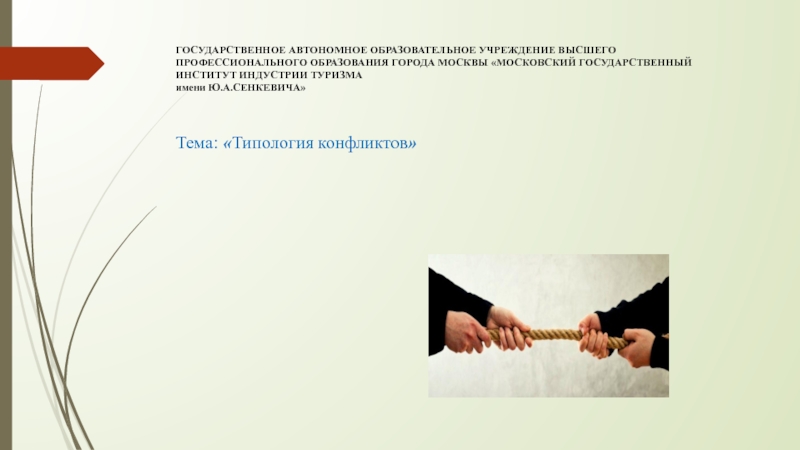- Главная
- Разное
- Дизайн
- Бизнес и предпринимательство
- Аналитика
- Образование
- Развлечения
- Красота и здоровье
- Финансы
- Государство
- Путешествия
- Спорт
- Недвижимость
- Армия
- Графика
- Культурология
- Еда и кулинария
- Лингвистика
- Английский язык
- Астрономия
- Алгебра
- Биология
- География
- Детские презентации
- Информатика
- История
- Литература
- Маркетинг
- Математика
- Медицина
- Менеджмент
- Музыка
- МХК
- Немецкий язык
- ОБЖ
- Обществознание
- Окружающий мир
- Педагогика
- Русский язык
- Технология
- Физика
- Философия
- Химия
- Шаблоны, картинки для презентаций
- Экология
- Экономика
- Юриспруденция
Aggression and attraction презентация
Содержание
- 1. Aggression and attraction
- 2. Aggression
- 3. What is 'aggressive' is partly shaped by
- 4. Although the problem of definition
- 5. Physically Verbally Emotionally
- 6. Instrumental aggression (proactive) is rational and calculated
- 7. Emotional (reactive) aggression is impulsive (also called
- 8. SANCTIONED VERSUS NONSANCTIONED AGGRESSION Every society classifies
- 9. Where aggression comes from? Combination of
- 10. Twin Studies: Concordance rates for monozygotic
- 11. SEROTONIN: Low serotonergic function are more
- 12. TESTOSTERONE: Rough correlations are found between testosterone
- 13. Estrogen decreases aggression. Thyroid hormones (related to thyroid gland): increase aggression.
- 14. Air pollution: noxious odors, fumes,
- 16. Age. Although most people become less aggressive
- 17. Education- Less education Employment- Lack of
- 18. Does Gender Play A Role in Aggression?
- 19. Theories of aggression
- 20. Explanations of aggression Explanations of aggression fall
- 21. Freud
- 22. Psychological Theories of aggression Social learning Theory
- 23. Psychological Theories of aggression Social learning Theory
- 27. Frustration and aggression In its
- 28. Excitation-transfer model Zillmann's (1988) excitation-transfer
- 29. EXPERIMENT. A student has been exercising at
- 31. Weapons Effect Рarticipants were seated at a
- 32. Weapons Effect Several other studies have replicated
- 33. Weapons Effect In one field experiment, a
- 34. Weapons Effect The more aggressive cues the
- 35. Weapons Effect What is amazing about this
- 36. PSYCHOSIS Schizophrenia, particularly paranoid schizophrenia patients, may
- 37. Dementia Impaired executive functioning Increased agitation
- 38. Alcohol Cocaine Methamphetamine Anabolic Steroids
- 39. Non pharmacological Pharmacological
- 40. Insight-oriented psychotherapy Cognitive–behaviour therapy Supportive psychotherapy
- 41. Medications are often used to manage agitated
- 42. Attraction
- 43. The Need to Belong The need to
- 44. Who Likes Whom? Social psychologists have labored
- 45. Who Likes Whom? Edward E. Jones found
- 46. What is Attractive? For both sexes, this
- 47. What is Attractive? For men, clothing represent
- 48. Cultural stereotypes of attraction Figure
- 49. What is Attractive? 1
- 50. What is Attractive? Symmetry is a powerful source of beauty
- 51. What influences attraction? We do not
- 52. Similarity Major Antecedents of Attraction
- 53. Similarity Major Antecedents of
- 54. Similarity According to the matching hypothesis, during
- 55. Dissimilarity in physical attractiveness increases the risk of breaking up. Source: White (1980).
- 56. Similarity Byrne et al. (1970) found that
- 57. Attraction Process
- 58. Attraction Process The first screen
- 59. A Two-Stage Model of the Attraction Process
- 60. Westgate West: Housing at MIT ~1949 (Festinger,
- 61. Proximity: Liking People who are Nearby Classic
- 62. Students, who lived far from each other
- 63. Proximity Why does it work? Availability Mere exposure
- 64. Mere Exposure Example (Moreland & Beach, 1992)
- 65. The more classes the girl attended the more attractive she was considered
- 66. Reciprocity One of the most potent determinants
- 67. Reciprocity A person’s level of self-esteem moderates
- 68. Physical Attractiveness: Getting Drawn In We react
- 69. Physical Attractiveness: Getting Drawn In
- 70. Teachers judge attractive students as more intelligent
- 71. Physical Attractiveness Good-looking people do have
- 72. Rejection Ostracism Being excluded, rejected, and ignored
- 73. Kip Williams has even designed a virtual
- 74. Social Exclusion (video)
- 75. Kip Williams has even designed a virtual
- 76. Behavioral Effects of Rejection Repeated rejection can
Слайд 3What is 'aggressive' is partly shaped by societal and cultural norms.
• behaviour that results in personal injury or destruction of property (Bandura, 1973);
• behaviour intended to harm another of the same species (Scherer, Abeles & Fischer, 1975);
• behaviour directed towards the goal of harming or injuring another living being who is motivated to avoid such treatment (Baron, 1977);
• the intentional infliction of some form of harm on others (Baron & Byrne, 2000);
• behaviour directed towards another individual carried out with the proximate (immediate) intent to cause harm (Anderson & Huesmann, 2003).
Слайд 4 Although the problem of definition is not fully resolved, researchers have
• punching an inflated plastic doll (Bandura, Ross & Ross, 1963);
• pushing a button that is supposed to deliver an electric shock to someone else (Buss, 1961);
• pencil-and-paper ratings by teachers and classmates of a child's level of aggressiveness (Eron, 1982);
• written self-report by institutionalized teenage boys about their prior aggressive behaviour (Leyens, Camino, Parke & Berkowitz, 1975);
• a verbal expression of willingness to use violence in an experimental laboratory setting (Geen, 1978).
Слайд 6Instrumental aggression (proactive) is rational and calculated
Aggression is used by
“Cold,” premeditated, calculated harmful behavior that is a means to some practical or material end.
Слайд 7Emotional (reactive) aggression is impulsive (also called hostile aggression) “hot,” angry
Aggression is driven by feelings (e.g., anger), often in the absence of a rational cost-benefit analysis
Слайд 8SANCTIONED VERSUS NONSANCTIONED AGGRESSION
Every society classifies aggression into its own socially
Socially sanctioned aggression, depends on culture, and it might include rough play, hunting, police actions, war.
Socially prohibited aggression in most cultures includes criminal assault, homicide, infanticide, child abuse, domestic violence, civil disturbance, and terrorism.
Слайд 9Where aggression comes from?
Combination of
biological factors like genetic, neurological, biochemical
our experiences, and
environment.
Слайд 10
Twin Studies: Concordance rates for monozygotic twins is higher than dizygotic
Chromosomal influence: More researchers concentrated on XYY syndrome (tall, below average IQ).
Слайд 11
SEROTONIN: Low serotonergic function are more common in impulsive aggression.
These
NOREPINEPHRINE AND EPINEPHRINE: stimulates aggressive behaviour.
Слайд 12TESTOSTERONE: Rough correlations are found between testosterone levels and aggression, high
Finally, testosterone hardly acts in isolation. We are just beginning to uncover neurochemical interactions that help to explain the role of this hormone in inappropriate aggression.
CORTISOL: Chronically low salivary cortisol levels are associated with disruptive, aggressive behavior in boys.
Decreased cortisol levels have also been reported in adolescent girls with conduct disorder.
Yet not all findings are consistent with this low-cortisol–aggression association
Слайд 13Estrogen decreases aggression.
Thyroid hormones (related to thyroid gland): increase aggression.
Слайд 14
Air pollution: noxious odors, fumes, cigarette smoke produce irritability and
Noise: Exposure to loud irritating voice may increase aggression.
Crowding: over crowding may increase aggression.
Heat: increased temperature (>32ºC) facilitate aggression.
Слайд 16Age. Although most people become less aggressive over time, a small
The most dangerous years for this small subset of individuals (and for society) are late adolescence and early adulthood. This is because aggressive acts become more extreme (e.g., weapons are used more frequently).
Official records show that violent criminal offending is highest for individuals (especially men) between 15 and 30 years old, and declines significantly after that. For example, the average age of murderers is about 27 years old.
Social class. Aggression rate is three times higher in lower socio-economic class than in the higher s.e. class.
I.Q.- Inversely proportional to violence.
Слайд 17
Education- Less education
Employment- Lack of sustained employment (lack of means)
Residential instability-
Слайд 18Does Gender Play A Role in Aggression?
Universally, men are more violent
Among people with mental disorders males and females don’t significantly differ in their base rates of aggression
Females feel the same amount of anger as males, however they are much less likely to act upon that anger
Important to note that most of these gender-related studies have been done only on PHYSICAL aggression
Boys are OVERTLY aggressive, while girls are indirectly, or relationally aggressive
“Boys may use their fists to fight, but at least it’s over quickly; girls use their tongues, and it goes on forever” (Britt Galen and Marion Underwood, 1997)
Слайд 20Explanations of aggression
Explanations of aggression fall into two broad classes, the
A debate over which of the two explanations is superior is an example of the nature-nurture controversy: is human action determined by our biological inheritance or by our social environment?
Слайд 21
Freud (1930) argued that human aggressions stems from a ‘Death Instinct’:
This
Lorenz (1966) adapted Darwin’s theory of evolution and the principle of survival of the fittest:
He argued that the ‘Fighting Instinct’ is inherent and necessary for survival
LORENZ
Слайд 22Psychological Theories of aggression
Social learning Theory (Bandura, 1973);
Albert Bandura and
The experiment involved exposing children to two different adult models, an aggressive model and a non-aggressive one. After witnessing the adult's behavior, the children would then be placed in a room without the model and were observed to see if they would imitate the behavior they had witnessed earlier. He predicted that children who observed an adult acting aggressively would be likely to act aggressively.
Слайд 23Psychological Theories of aggression
Social learning Theory
Aggression is initially learned from social
Слайд 24
The case of social learning: Media Effects
A meta-analytic review of 431
(Bushman, B. J., & Huesmann, L. R. (2006). Shortterm and long-term effects of violent media on aggression in children and adults. Archives of Pediatrics and Adolescent Medicine, 160, 348–352.)
Слайд 25
The case of social learning: Media Effects
A recent meta-analysis of more
This meta-analysis showed that violent games increase aggressive thoughts, angry feelings, and aggressive behaviors and decrease empathic feelings and prosocial behaviors. Similar effects were obtained for male and female gamers, regardless of their age, and regardless of whether they lived in Western or Eastern countries.
(Anderson, C. A., Shibuya, A., Ihori, N., Swing, E. L., Bushman, B.J., Sakamoto, A., Rothstein, H. R., & Saleem, M. (2010). Violent video game effects on aggression, empathy, and prosocial behavior in Eastern and Western countries. Psychological Bulletin, 136, 151–173.)
Слайд 27Frustration and aggression
In its original form, the frustration-aggression hypothesis linked
Berkowitz (1993) has proposed that aversive events such as frustrations, provocations, loud noises, uncomfortable temperatures, and unpleasant events produce negative affect.
Negative affect automatically stimulates various thoughts, memories, expressive motor reactions, and physiological responses associated with fight tendencies
The fight associations give rise to rudimentary feelings of anger.
Слайд 28Excitation-transfer model
Zillmann's (1988) excitation-transfer model. The expression of aggression is
• arousal or excitation from another source;
• the person's interpretation of the arousal state, such that an aggressive response seems appropriate.
Слайд 29EXPERIMENT. A student has been exercising at the gym and is
Although the event might ordinarily be mildly annoying, this time the residual excitation from the gym session (now forgotten) triggers verbal abuse from the student.
Слайд 31Weapons Effect
Рarticipants were seated at a table that had a shotgun
The participant was supposed to decide what level of electric shock to deliver to a confederate, and the electric shocks were used to measure aggression. The experimenter told participants to ignore the items, but apparently they could not.
Participants who saw the guns were more aggressive than were participants who saw the sports items.
Слайд 32Weapons Effect
Several other studies have replicated this effect, which has been
Men in one study who interacted with a gun for 15 minutes had higher testosterone levels compared to men who interacted with a toy for 15 minutes, and the higher the testosterone level, the more aggressive they were afterwards
Слайд 33Weapons Effect
In one field experiment, a confederate driving a pickup truck
Слайд 34Weapons Effect
The more aggressive cues the trapped motorists saw, the more
Слайд 35Weapons Effect
What is amazing about this study is that you would
It is certainly much safer to honk at someone who is not driving around with weapons and violent bumper stickers.
These findings again bring up the duplex mind. Horn honking was probably not a product of logical, conscious thought. Most likely, it was mediated by the automatic system.
Слайд 36PSYCHOSIS
Schizophrenia, particularly paranoid schizophrenia patients, may be at risk, especially in
General risk factors for violence in such patients include:
Presence of hallucinations, delusions, or bizarre behaviors (paranoid patients with delusions may be at a higher risk to commit a violent act because of their ability to plan and their retention of some reality testing)
Слайд 37Dementia
Impaired executive functioning
Increased agitation
Sometimes hallucinations and/or delusions
Mania
More likely
26% of patients with mania attack someone within the first 24 hours of hospitalization
Depression
Despair, in rare cases could lead to striking out against other people
Murder-suicide is suicidal within 1 week of a homicide; in couples it is highly associated with jealousy (Felthous et al, 1995)
The individual can no longer endure a life without what is perceived to be a vital element (e.g., a spouse, family, job, health) but can’t bear the thought of the other persons carrying on without him, so he forces the others to joint him in death. Suicidal mother hence, should always be asked about her children.
Слайд 40 Insight-oriented psychotherapy
Cognitive–behaviour therapy
Supportive psychotherapy
Behaviour modification
Anger management
Слайд 41Medications are often used to manage agitated behavior
These include :
Antipsychotics
Benzodiazepines (eg lorazepam)
Mood stabilizers(eg lithium, valproate, and carbamazepine )
Antidepressants
Anxiolytics
Слайд 43The Need to Belong
The need to belong is a basic human
We care deeply about what others think of us.
Those with a network of close social ties tend to be happier, healthier, and more satisfied with life than those who are more isolated.
Слайд 44Who Likes Whom?
Social psychologists have labored long and hard to study
Social psychology’s task has been to identify those factors.
Слайд 45Who Likes Whom?
Edward E. Jones found that people seem to have
Not much will prove surprising in these research findings. People like good-looking, friendly people who are similar to themselves in important ways, and they like people who are nice to them.
Слайд 46What is Attractive?
For both sexes, this standard includes large eyes and
For women a small nose and chin, narrow cheeks and high eyebrows are considered attractive;
For men a large chin is considered attractive.
Typicality is a source of beauty
Average or composite faces are more attractive than individual faces
Слайд 47What is Attractive?
For men, clothing represent wealth and status
High wealth and
Standards of beauty change over time.
The ideal beauty standard for American women has become thinner over time.
Body shape influences attractiveness
Cultural variation in ideal body weight
Cultural stereotypes of attraction
Слайд 51What influences attraction?
We do not simply find ourselves attracted to
2) Proximity - liking others who are physically close to us 3) Familiarity – liking those we have frequent contact with 4) Reciprocity – liking others who like us
Слайд 52Similarity
Major Antecedents of Attraction
People who are similar are attractive
Shared values, goals
Слайд 53Similarity
Major Antecedents of Attraction
Spouses are similar in many aspects:
Couples who are more similar in attractiveness are more likely to progress to commit relationship.
Слайд 54Similarity
According to the matching hypothesis, during an interaction, people tend to
Слайд 55Dissimilarity in physical attractiveness increases the risk of breaking up. Source:
Слайд 56Similarity
Byrne et al. (1970) found that couples on blind dates who
Miller and Perlman (2009): dissimilar views do not matter as long as neither partner perceive them as significant.
Слайд 58Attraction Process
The first screen is the negative screen of dissimilarity.
The second screen is the positive screen of similarity where people are attracted to other people who are highly similar while being indifferent towards people with low similarity (Byrne et al., 1986).
Слайд 60Westgate West: Housing at MIT ~1949
(Festinger, 1950)
Proximity: Liking People who are
The place where we live, influences the friends we make.
Слайд 61Proximity: Liking People who are Nearby
Classic study by Festinger, Schachter and
This indicates the significance of proximity in the initial stages of a relationship/friendship.
Слайд 62Students, who lived far from each other are less to become
Close friends:
Next door neighbors: 41%
Two doors down: 22%
Opposite ends of hallway: 10%
“Contrary to popular belief, I do not believe that friends are necessarily the people you like best; they are merely the people who got there first.” (Ustinov, 1977)
Proximity: Liking People who are Nearby
Слайд 64Mere Exposure Example
(Moreland & Beach, 1992)
Procedure
Four girls with the same appearance
New girls with the same appearance attended a class in a group of students
they did not communicate with other students
1 girl 0 times
1 girl 5 classes
1 girl 10 classes
1 girl 15 classes
Students rate girls on traits at end of semester
Слайд 66Reciprocity
One of the most potent determinants of our liking someone is
If we believe somebody else likes us, we will be a more likable person in their presence; this will lead them to actually like us more, which leads to a self-fulfilling prophecy.
If someone likes you, initially it is very favorable, but if that liking is not returned, it can be a burden.
Слайд 67Reciprocity
A person’s level of self-esteem moderates how we are affected by
Swann and colleagues (1992) have shown that people with high self-esteem like and interact with those who like them, but people with low self-esteem prefer to interact with somebody who criticized them.
Слайд 68Physical Attractiveness: Getting Drawn In
We react more favorably to others who
Bias for beauty is pervasive.
Слайд 70Teachers judge attractive students as more intelligent than unattractive students (Clifford
Adults, and nurses in pediatric wards, punish unattractive children more harshly than attractive children (Dion, 1974)
Attractive people make more money (Hamermesh & Biddle, 1994) and get better job ratings from bosses (Hosoda et al., 2003)
Physical Attractiveness
Слайд 71Physical Attractiveness
Good-looking people do have more friends, better social skills.
But beauty is not related to objective measures of intelligence.
Слайд 72Rejection
Ostracism
Being excluded, rejected, and ignored
Effects of rejection
Inner states are almost uniformly
Fears of rejection are linked to eating disorders
Rejected people are more likely to eat fattening or junk food
Слайд 73Kip Williams has even designed a virtual game called Cyberball that
Слайд 75Kip Williams has even designed a virtual game called Cyberball that
Слайд 76Behavioral Effects of Rejection
Repeated rejection can create aggression
Aggression can lead to
Common theme in school shootings is social exclusion
Loneliness is bad for physical health
